HOTPOINT WDD 9640B EU, WDD9640B User Manual [fr]

Instructions for use
WASHER-DRYER
|
GB |
|
F |
|
DE |
|
||
|
|
|
|
|
|
|
|
|
|
English,1 |
Français,13 |
Deutsch,25 |
|||||
|
|
|
|
|
|
|
||
|
NL |
|
ES |
|
PT |
|
||
|
|
|
|
|
|
|
||
|
|
|
Español,49 |
Português,61 |
||||
Nederlands,37 |
||||||||
WDD 9640
! |
This symbol reminds you to read this instruction manual. |
GB |
|
|
|
|
|
|
Contents
Installation, 2-3
Unpacking and levelling
Connecting the electricity and water supplies
The first wash cycle
Technical data
Description of the washer-dryer, 4-5
Control panel
Display
How to run a wash cycle or a drying cycle, 6
Wash cycles and functions, 7
Table of wash cycles Wash functions
Detergents and laundry, 8
Detergent dispenser drawer
Preparing the laundry
Special wash cycles
Load balancing system
Precautions and tips, 9
General safety Disposal
Opening the porthole door manually
Care and maintenance, 10
Cutting off the water or electricity supply Cleaning the washer-dryer
Cleaning the detergent dispenser drawer Caring for the door and drum of your appliance Cleaning the pump
Checking the water inlet hose
Troubleshooting, 11
Service, 12
1
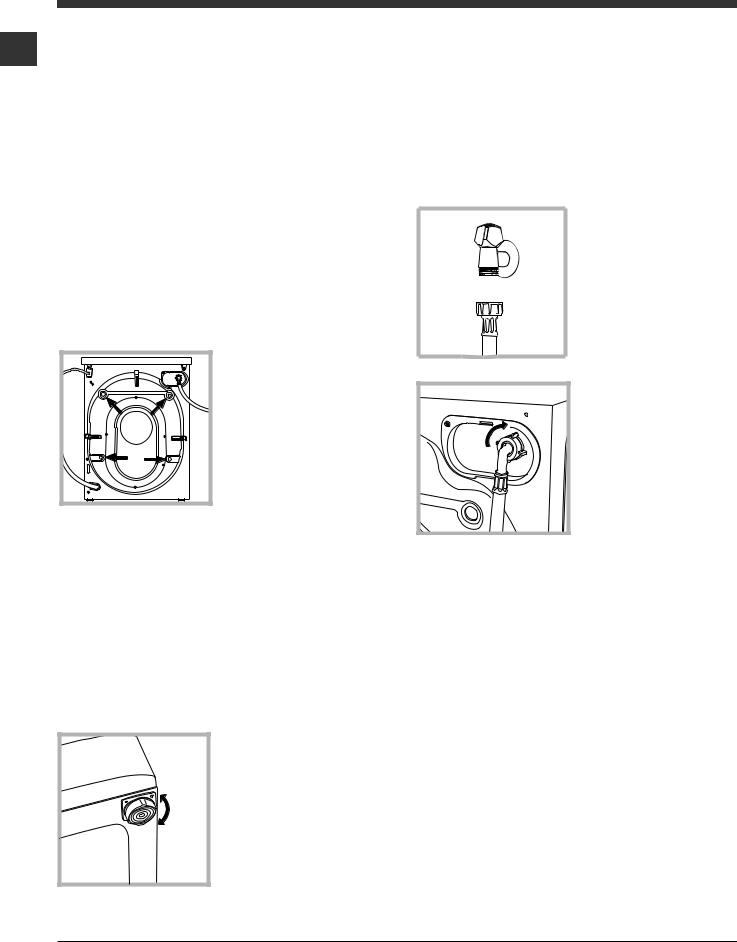
Installation
! This instruction manual should be kept in a safe place for GB future reference. If the washer-dryer is sold, transferred or moved, make sure that the instruction manual remains with
the machine so that the new owner is able to familiarise himself/herself with its operation and features.
! Read these instructions carefully: they contain vital information relating to the safe installation and operation of the appliance.
Unpacking and levelling
Unpacking
1.Remove the washer-dryer from its packaging.
2.Make sure that the washer-dryer has not been damaged during the transportation process. If it has been damaged, contact the retailer and do not proceed any further with the installation process.
3. Remove the 4 protective screws (used during transportation) and the rubber washer with the corresponding spacer, located on the rear part of the appliance (see figure).
4.Close off the holes using the plastic plugs provided.
5.Keep all the parts in a safe place: you will need them again if the washer-dryer needs to be moved to another location.
! Packaging materials should not be used as toys for children.
Levelling
1. Install the washer-dryer on a flat sturdy floor, without resting it up against walls, furniture cabinets or anything else.
2. If the floor is not perfectly level, compensate for any unevenness by tightening or loosening the adjustable front feet (see figure); the angle of inclination, measured in relation to the worktop, must not exceed 2°.
Levelling the machine correctly will provide it with stability, help to avoid vibrations and excessive noise and prevent it from shifting while it is operating. If it is placed on carpet or a rug, adjust the feet in such a way as to allow a sufficient ventilation space underneath the washer-dryer.
Connecting the electricity and water supplies
Connecting the water inlet hose
1. Connect the supply pipe by screwing it to a cold water tap using a ¾ gas threaded connection (see figure).
Before performing the connection, allow the water to run freely until it is perfectly clear.
2. Connect the inlet hose to the washer-dryer by screwing it onto the corresponding water inlet of the appliance, which is situated on the top right-hand side of the rear part of the appliance (see figure).
3. Make sure that the hose is not folded over or bent.
!The water pressure at the tap must fall within the values indicated in the Technical details table (see page 3).
!If the inlet hose is not long enough, contact a specialised shop or an authorised technician.
!Never use second-hand hoses.
!Use the ones supplied with the machine.
2
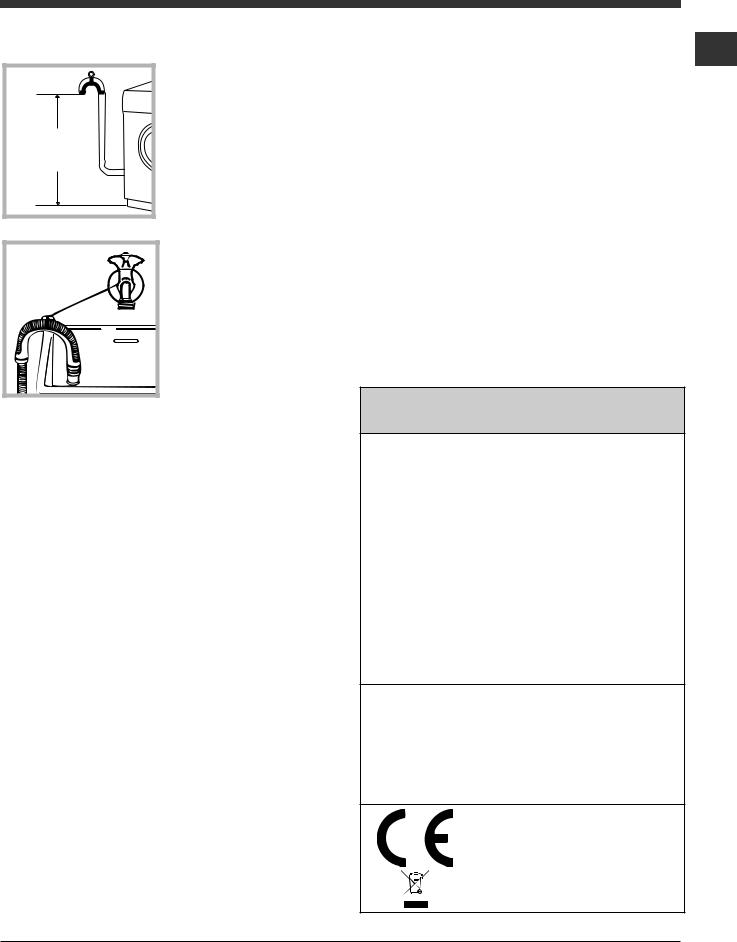
Connecting the drain hose
65 - 100 cm |
Connect the drain hose, without bending it, to a drainage duct or a wall drain located at a height between 65 and 100 cm from the floor;
alternatively, rest it on the side of a washbasin or bathtub, fastening the duct supplied to the tap (see figure). The free end of the hose should not be underwater.
! We advise against the use of hose extensions; if it is absolutely necessary, the extension must have the same diameter as the original hose and must not exceed 150 cm in length.
Electrical connections
Before plugging the appliance into the electricity socket, make sure that:
•the socket is earthed and complies with all applicable laws;
•the socket is able to withstand the maximum power load of the appliance as indicated on the Technical Data Plate fixed on the machine;
•the power supply voltage falls within the values indicated on the Technical Data Plate fixed on the machine;
•the socket is compatible with the plug of the washer-dr- yer. If this is not the case, replace the socket or the plug.
!The washer-dryer must not be installed outdoors, even in covered areas. It is extremely dangerous to leave the appliance exposed to rain, storms and other weather conditions.
!When the washer-dryer has been installed, the electricity socket must be within easy reach.
! Do not use extension cords or multiple sockets.
GB
!The cable should not be bent or compressed.
!The power supply cable must only be replaced by authorised technicians.
Warning! The company shall not be held responsible in the event that these regulations are not respected.
The first wash cycle
Once the appliance has been installed, and before you use it for the first time, run a wash cycle with detergent and no laundry, using the wash cycle  (60°C).
(60°C).
Technical data
Model |
WDD 9640 |
|
|
|
|
|
width 59.5 cm |
|
Dimensions |
height 85 cm |
|
|
depth 60,5 cm |
|
|
|
|
Capacity |
from 1 to 9 kg for the wash programme |
|
from 1 to 6 kg for the drying programme |
||
|
||
|
|
|
Electrical |
please refer to the technical data plate fixed |
|
connections |
to the machine |
|
|
|
|
|
maximum pressure 1 MPa (10 bar) |
|
Water connections |
minimum pressure 0.05 MPa (0.5 bar) |
|
|
drum capacity 62 litres |
|
|
|
|
Spin speed |
up to 1400 rotations per minute |
Energy rated programmes according to regulation EN 50229
Wash: programme  ; temperature 60°C
; temperature 60°C
(2nd press of the button); using a load of 9 kg.
Drying: the smaller load must be dried by selecting the “EXTRA” dryness level. The load must consist of 3 sheets, 2 pillowcases and 1 hand towel;
the remainder of the load must be dried by selecting the “EXTRA” dryness level.
This appliance conforms to the following EC Directives:
-2004/108/EC (Electromagnetic Compatibility)
-2006/95/EC (Low Voltage)
-2002/96/EC
3
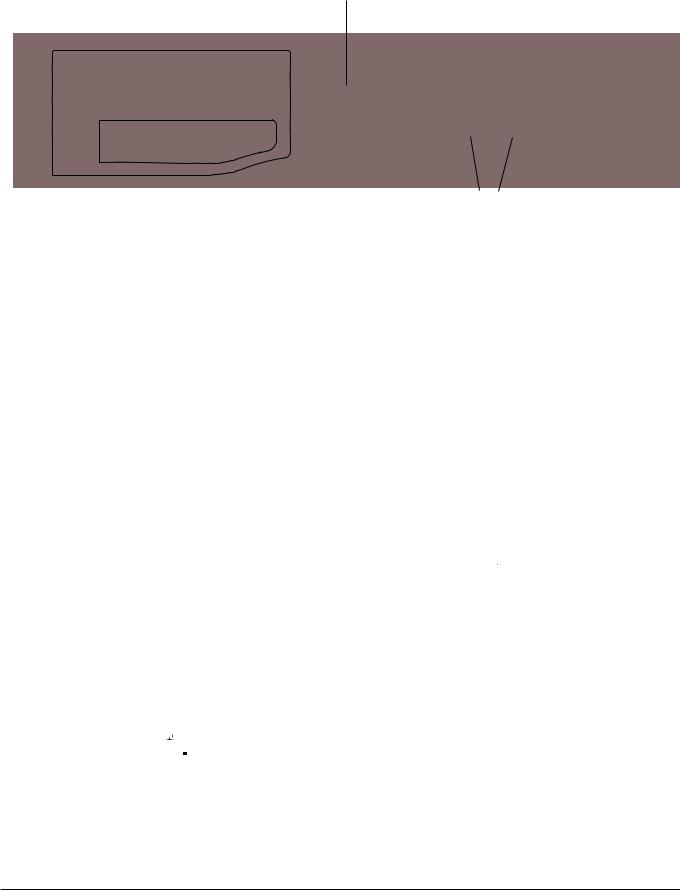
Description of the washer-dryer
|
|
|
|
|
|
|
|
|
Control panel |
|
CLEANING |
|
DRYING |
GB |
|
|
||||
|
|
|
||||
|
|
|
|
|||
|
|
ON/OFF |
|
ACTION |
|
button |
|
|
button |
|
button |
|
|
|
|
|
|
|
|
|
DISPLAY
|
|
|
|
|
|
|
|
|
|
START/PAUSE |
|
|
|
|
|
|
|
|
|
|
|
|
|
|
|
|
|
|
|
|
|
|
|
|
|
|
|
|
|
|
|
|
|
|
|
|
MEMORY |
|
|
|
|
|
||
|
|
WASH |
|
|
|
|
|
button with |
||
|
|
button |
|
FUNCTION |
|
|
indicator light |
|||
|
|
CYCLE |
|
|
|
|||||
Detergent dispenser drawer |
|
|
|
|||||||
SELECTOR |
|
|
|
buttons |
|
|
|
|||
|
|
|
|
|
|
|
|
|||
|
|
buttons |
|
|
|
|
|
|
|
|
|
|
|
|
|
|
DELAY |
|
TEMPERATURE |
||
|
|
|
|
|
|
TIMER |
|
|||
|
|
|
|
ANTI |
|
|
button |
|||
|
|
|
|
|
button |
|
|
|
||
|
|
|
ALLERGY |
|
|
|
CHILD LOCK |
|||
|
|
|
RINSE |
|
|
|
||||
|
|
|
|
|
|
button |
||||
|
|
|
|
button |
|
|
|
|||
|
|
|
|
|
|
|
|
|
|
|
Detergent dispenser drawer: used to dispense detergents and washing additives (see “Detergents and laundry”).
ON/OFF button  : press this briefly to switch the machine on or off. The START/PAUSE indicator light, which flashes slowly in a green colour shows that the machine is switched on. To switch off the washer-dryer during the wash cycle, press and hold the button for approximately 3 seconds; if the button is pressed briefly or accidentally the machine will not switch off. If the machine is switched off during a wash cycle, this wash cycle will be cancelled.
: press this briefly to switch the machine on or off. The START/PAUSE indicator light, which flashes slowly in a green colour shows that the machine is switched on. To switch off the washer-dryer during the wash cycle, press and hold the button for approximately 3 seconds; if the button is pressed briefly or accidentally the machine will not switch off. If the machine is switched off during a wash cycle, this wash cycle will be cancelled.
WASH CYCLE SELECTOR buttons: used to set the desired wash cycle (see “Table of wash cycles”).
MEMORY button: press and hold the button to store a cycle with your own set of preferences in the memory of the machine. To recall a previously stored cycle, press the MEMORY button.
FUNCTION buttons: press the button to select the desired function. The corresponding indicator light on the display will switch on.
CLEANING ACTION button  : to select the desired wash intensity.
: to select the desired wash intensity.
ANTI ALLERGY RINSE button  : press to select the desired rinse type.
: press to select the desired rinse type.
DRYING button  : press to set a drying cycle.
: press to set a drying cycle.
TEMPERATURE button  : press to decrease the temperature: the value will be shown on the display.
: press to decrease the temperature: the value will be shown on the display.
CHILD LOCK button  : to activate the control panel lock, press and hold the button for approximately 2 seconds. When the symbol
: to activate the control panel lock, press and hold the button for approximately 2 seconds. When the symbol  is illuminated, the control panel is locked. This means it is possible to prevent wash cycles from being modified accidentally, especially where there are children in the home. To deactivate the control panel lock, press and hold the button for approximately 2 seconds.
is illuminated, the control panel is locked. This means it is possible to prevent wash cycles from being modified accidentally, especially where there are children in the home. To deactivate the control panel lock, press and hold the button for approximately 2 seconds.
DELAY TIMER button  : press to set a delayed start time for the selected wash cycle. The delay time will be shown on the display.
: press to set a delayed start time for the selected wash cycle. The delay time will be shown on the display.
START/PAUSE button with indicator light: when the green indicator light flashes slowly, press the button to start a wash cycle. Once the cycle has started the indicator light will remain lit in a fixed manner. To pause the wash cycle, press the button again; the indicator light will flash in an orange colour. If the symbol  is not illuminated, the door may be opened. To start the wash cycle from the point at which it was interrupted, press the button again.
is not illuminated, the door may be opened. To start the wash cycle from the point at which it was interrupted, press the button again.
Standby mode
This washer-dryer, in compliance with new energy saving regulations, is fitted with an automatic standby system which is enabled after about 30 minutes if no activity is detected. Press the ON-OFF button briefly and wait for the machine to start up again.
4
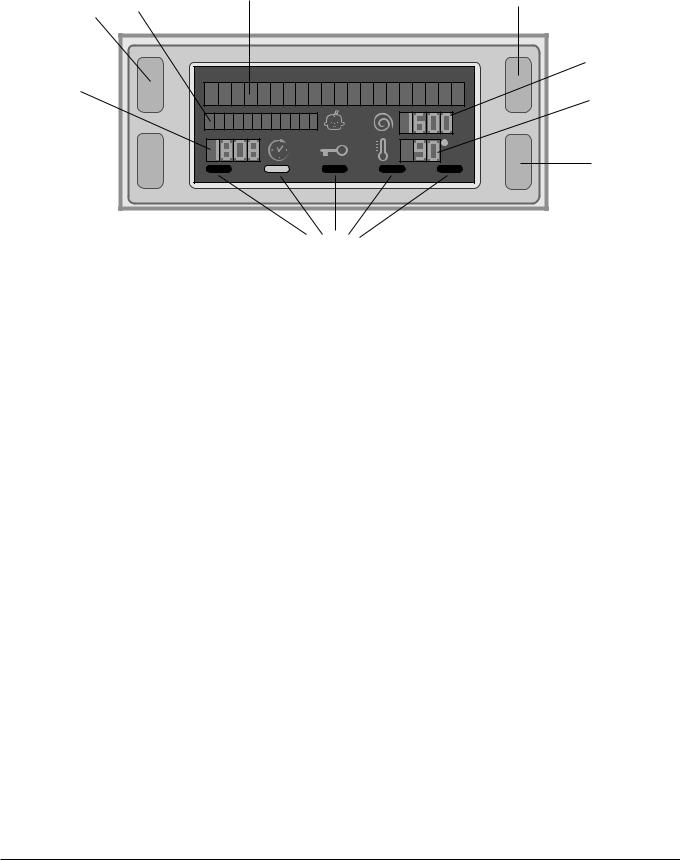
|
|
|
|
|
|
Display |
|
|
|
|
|
|
|
|
|
GB |
|
|
|
|
|
|
|
|
|
A |
|
|
|
Z |
B |
X |
|||
|
|
|
|
|
|
|
D |
C |
E |
|
|
|
Y |
F
The display is useful when programming the machine and provides a great deal of information.
The upper two strings A and B are used to display the selected wash cycle or the type of drying selected, the current wash cycle phase (the selected dryness level or drying time) and all the indications relating to the progress status of the cycle.
String C shows the time remaining until the end of the wash cycle in progress and, if a DELAYED START has been set, the time remaining until the start of the selected wash cycle.
String D shows the maximum spin speed value (this depends on the selected wash cycle); if the wash cycle does not include a spin cycle, the string remains unused.
String E shows the maximum temperature value which may be selected (this depends on the wash cycle used); if the temperature of the wash cycle cannot be modified, the string remains unused.
Indicator lights F correspond to the functions and light up when the selected function is compatible with the set wash cycle.
Door locked symbol 
If the symbol is lit, this indicates that the washer-dryer door is blocked to prevent it from being opened accidentally. To prevent any damage from occurring, wait for the symbol to switch itself off before opening the appliance door.
N.B.: if the DELAYE TIMER function has been activated, the door cannot be opened; pauses the machine by pressing the START/PAUSE button if you wish to open it.
! The first time the machine is switched on, you will be asked to select the language and the display will automatically show the language selection menu.
To select the desired language press the X and Y buttons; to confirm the selection press the Z button.
To change the language switch off the machine and press buttons X, Y, Z simultaneously until an alarm is heard: the language-selection menu will be displayed again.
5

How to run a wash cycle or a drying cycle
1. SWITCH THE MACHINE ON. Press the On/Off button GB ; the text POWER ON will appear on the display and the
START/PAUSE indicator light will flash slowly in a green colour.
2.LOAD THE LAUNDRY. Open the porthole door. Load the laundry, making sure you do not exceed the maximum load value indicated in the table of programmes on the following page.
3.MEASURE OUT THE DETERGENT. Open the detergent dispenser drawer and pour the detergent into the relevant compartments as described in “Detergents and laundry”.
4.CLOSE THE DOOR.
5.SELECT THE WASH CYCLE. Press one of the WASH CYCLE SELECTOR buttons to select the required wash cycle; the name of the wash cycle will appear on the display. A temperature and spin speed is set for each wash cycle; these may be adjusted. The duration of the cycle will appear on the display.
6.CUSTOMISE THE WASH CYCLE. Use the relevant buttons:
Modifying the temperature. The machine automatically select the maximum temperature set for the selected
wash cycle; this values cannot therefore be increased. The temperature can be decreased by pressing the 
 button, until the cold wash “OFF” setting is reached. If this button is pressed again, the maximum values are restored.
button, until the cold wash “OFF” setting is reached. If this button is pressed again, the maximum values are restored.
Setting a delayed start.
To set a delayed start for the selected programme, press the corresponding button repeatedly until the required delay period has been reached. When this option is enabled, the 

 symbol lights up on the display. To remove the delayed start function press the button until the text “OFF” appears on the display.
symbol lights up on the display. To remove the delayed start function press the button until the text “OFF” appears on the display.
Setting the drying cycle.
The desired drying cycle type may be set by pressing the DRYING button  once or several times. Two options are available:
once or several times. Two options are available:
A - Based on the how damp the clothes are once they have been dried:
Iron: suitable for clothes which will need ironing afterwards. the remaining dampness softens creases, making them easier to remove.
Hanger: ideal for clothes which do not need to be dried fully. Cupboard: suitable for laundry which can be put back in a cupboard without being ironed.
Extra: suitable for garments which need to be dried completely, such as sponges and bathrobes.
B - Based on a set time period: between 20 and 180 minutes. To exclude the drying phase press the relevant button until the text OFF appears on the display.
If your laundry load to be washed and dried is much greater than the maximum stated load, perform the wash cycle, and when the cycle is complete, divide the garments into groups and put some of them back in the drum. At this point, follow the instructions provided for a “Drying only” cycle. Repeat this procedure for the remainder of the load. A cooling-down period is always added to the end of each drying cycle.
Drying only
Use the cycle selector knob to select a drying cycle (


 ) in accordance with the type of fabric. The desired drying level or time may also be set using the DRYING button
) in accordance with the type of fabric. The desired drying level or time may also be set using the DRYING button  . Selecting the cotton drying cycle through the programme selector knob and pressing the “Eco” button activates an automatic drying cycle that allows for saving energy, thanks to an optimal combination of air temperature and cycle duration; the display will visualise the “Eco” dryness level.
. Selecting the cotton drying cycle through the programme selector knob and pressing the “Eco” button activates an automatic drying cycle that allows for saving energy, thanks to an optimal combination of air temperature and cycle duration; the display will visualise the “Eco” dryness level.
Set the desired wash intensity.
Option makes it possible to optimise washing based on the level of soil in the fabrics and on desired wash cycle intensity. Select the wash programme: the cycle will be automatically
makes it possible to optimise washing based on the level of soil in the fabrics and on desired wash cycle intensity. Select the wash programme: the cycle will be automatically
set to “Normal” as optimised for garments with an average level of soil (this setting is not applicable to the “Wool” cycle, which is automatically set to “Delicate”).
For heavily-soiled garments press button  until the “Super Wash” level is reached. This level ensures a high-performance wash due to a larger quantity of water used in the initial phase of the cycle and due to increased drum rotation. It is useful when removing the most stubborn stains.
until the “Super Wash” level is reached. This level ensures a high-performance wash due to a larger quantity of water used in the initial phase of the cycle and due to increased drum rotation. It is useful when removing the most stubborn stains.
It can be used with or without bleach. If you wish to bleach the items insert the additional compartment (4) into compartment 1. When pouring the bleach, be careful not to exceed the “max” level marked on the central pivot (see figure pag. 8).
For lightly-soiled garments or a more delicate treatment of the fabrics, press button “ ” until the “Delicate” level is reached. The cycle will reduce the drum rotation to ensure washing results are perfect for delicate garments. If the current selection can be neither set nor changed, the display will show “Not allowed”.
” until the “Delicate” level is reached. The cycle will reduce the drum rotation to ensure washing results are perfect for delicate garments. If the current selection can be neither set nor changed, the display will show “Not allowed”.
Set the rinse type.
Option makes it possible to select the desired rinse type for sensitive skin. Press the button once for the “Extra Rinse” level, which makes it possible to select an additional rinse after the standard cycle rinse and remove all traces of detergent. Press the button again for the “Sensitive Skin” level, which makes it possible to select two additional rinses to the standard cycle rinses; it is recommended for very sensitive skin. Press the button for the third time for the “Anti allergy Rinse” level, which makes it possible to select three additional rinses to the standard cycle rinses and remove major allergens such as pollen, mites, cat and dog hair. Press the button again to go back to the “Normal Rinse” rinse type. If the current adjustment can be neither set nor changed, the display will show “Not allowed”.
Modifying the cycle settings.
•Press the button to enable the function; the indicator light corresponding to the button will switch on.
•Press the button again to disable the function; the indicator light will switch off.
!If the selected function is not compatible with the programmed wash cycle, the indicator light will flash and the function will not be activated.
!If the selected function is not compatible with another function which has been selected previously, the indicator light corresponding to the first function selected will flash and only the second function will be activated; the indicator light corresponding to the enabled function will remain lit.
!The functions may affect the recommended load value and/or the duration of the cycle.
7.START THE PROGRAMME. Press the START/PAUSE button. The corresponding indicator light will become green, remaining lit in a fixed manner, and the door will be locked (the DOOR LOCKED symbol will be on). During the wash cycle, the name of the phase in progress will appear on
the display. To change a wash cycle while it is in progress, pause the washer-dryer using the START/PAUSE button (the START/PAUSE indicator light will flash slowly in an orange colour); then select the desired cycle and press the START/PAUSE button again. To open the door while a cycle is in progress, press the START/PAUSE button; if the
DOOR LOCKED  symbol is switched off the door may be opened. Press the START/PAUSE button again to restart the wash cycle from the point at which it was interrupted.
symbol is switched off the door may be opened. Press the START/PAUSE button again to restart the wash cycle from the point at which it was interrupted.
8.THE END OF THE WASH CYCLE. This will be indicated by the text “END OF CYCLE” on the display; when the DOOR LOCKED  symbol switches off the door may be opened. Open the door, unload the laundry and switch off the machine.
symbol switches off the door may be opened. Open the door, unload the laundry and switch off the machine.
! If you wish to cancel a cycle which has already begun, press and hold the  button. The cycle will be stopped and the machine will switch off.
button. The cycle will be stopped and the machine will switch off.
6
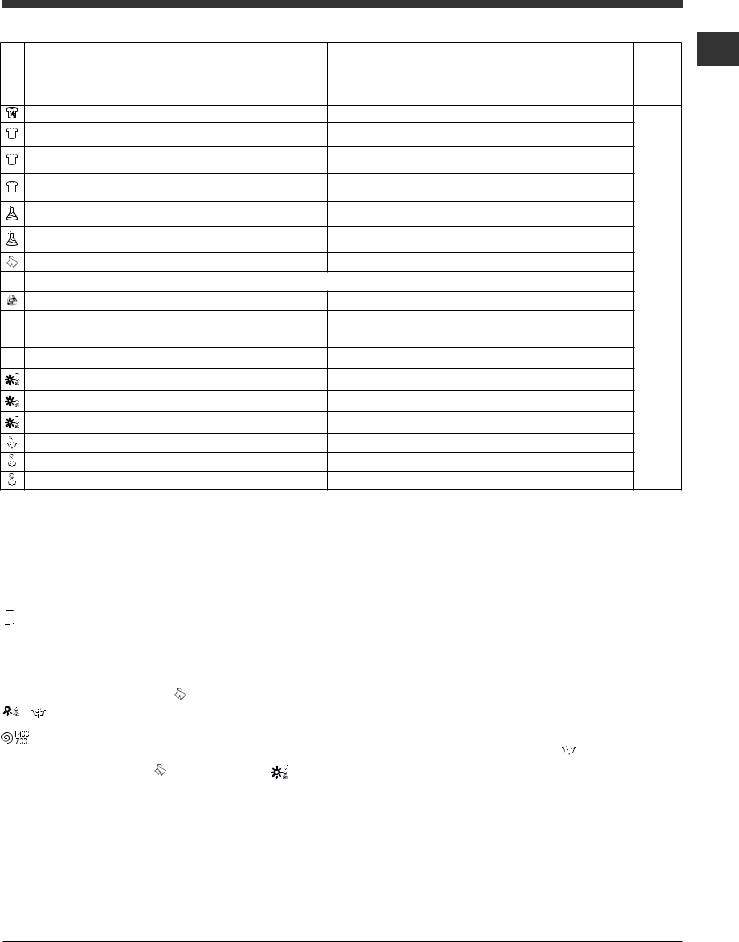
Wash cycles and functions
Table of wash cycles
Washcycles Description of the wash cycle
Anti Stain
Cotton Prewash (1st press of the button): extremely soiled whites and resistant colours.
White Cottons (1) (2nd press of the button): heavily soiled whites and delicate colours.
Cottons Coloured (2) (3rd press of the button): lightly soiled whites and delicate colours.
Synthetics Resistant (1st press of the button): heavily soiled resistant colours.
Synthetics Delicate (2nd press of the button): lightly soiled resistant colours.
Delicates
M Memory: allows for any wash cycle to be stored.
Woolmark Platinum (Wool): for wool, cashmere, etc.
Fastwash 30' (1st press of the button): to refresh lightly soiled 
 garments quickly (not suitable for wool, silk and clothes which require washing by hand).
garments quickly (not suitable for wool, silk and clothes which require washing by hand).

 Ready to Wear (2nd press of the button)
Ready to Wear (2nd press of the button)
Cotton Dry (1st press of the button)
Synthetics Dry (2nd press of the button)
Wool Dry (3rd press of the button)
Spin (1st press of the button)
Rinse (2nd press of the button)
Pump out (3rd press of the button)
Max. |
Max. |
|
|
Detergents |
|
Max. |
|
|
|
|
|
|
|||
temp. |
speed |
Drying |
|
|
|
|
load |
(°C) |
(rpm) |
|
Pre- |
Wash |
Bleach |
Fabric |
(kg) |
|
|
|
Wash |
|
|
softener |
|
40° |
1400 |
|
- |
|
- |
|
5 |
90° |
1400 |
|
|
|
- |
|
9 |
60° |
1400 |
|
- |
|
|
|
9 |
40° |
1400 |
|
- |
|
|
|
9 |
60° |
800 |
|
- |
|
|
|
4 |
40° |
800 |
|
- |
|
|
|
4 |
30° |
0 |
|
- |
|
- |
|
1 |
40° |
|
|
|
|
|
|
|
800 |
- |
- |
2 |
||||
30° |
800 |
|
- |
|
- |
|
3.5 |
30° |
1400 |
|
- |
|
- |
|
1 |
- |
- |
|
- |
- |
- |
- |
6 |
- |
- |
|
- |
- |
- |
- |
4 |
- |
- |
|
- |
- |
- |
- |
2 |
- |
1400 |
|
- |
- |
- |
- |
9 |
- |
1400 |
|
- |
- |
- |
|
9 |
- |
0 |
- |
- |
- |
- |
- |
9 |
|
|
|
|
|
|
|
|
GB
Cycle duration
.display the on checked be can cycles wash the of duration The
The length of cycle shown on the display or in this booklet is an estimation only and is calculated assuming standard working conditions. The actual duration can vary according to factors such as water temperature and pressure, the amount of detergent used, the amount and type of load inserted, load balancing and any wash options selected.
For all Test Institutes:
1)Test wash cycle in compliance with regulation EN 50229: set wash cycle  60°C (2nd press of the button).
60°C (2nd press of the button).
2)Long wash cycle for cottons: set wash cycle  40°C (3rd press of the button).
40°C (3rd press of the button).
Wash functions


 Timer Saver
Timer Saver
If you select this option, the wash cycle duration will be reduced by up to 50%, depending on the selected cycle, thereby guaranteeing simultaneous water and energy saving. Use this cycle for lightly soiled garments.
! It cannot be used with the  , ,
, ,  , “Ready to Wear”,
, “Ready to Wear”, 


 ,
,  .
.
Press this button to reduce the spin speed. |
|
! It cannot be used with the , “Ready to Wear”, |
and |
“Pump out”. |
|
 Eco
Eco
The Eco function saves energy by not heating the water used to wash your laundry – an advantage both to the environment and to your energy bill. Instead, intensified wash action and water optimisation ensure great wash results in the same average time of a standard cycle.
For the best washing results we recommend the usage of a liquid detergent.
! It cannot be used with the  ,
,  (90°C),
(90°C),  ,
,  , “Ready to Wear”, “Synthetics Dry”, “Wool Dry”,
, “Ready to Wear”, “Synthetics Dry”, “Wool Dry”,  .
.
By selecting the drying function as well, an automatic drying cycle automatically activates at the end of the wash cycle – it too allows for saving energy, thanks to the optimal combination of air temperature and cycle duration; the display will visualise the “Eco” dryness level,
! It can be activated with programmes “White Cottons” and “Cottons Coloured”.
7

Detergents and laundry
Detergent dispenser drawer
GB
Good washing results also depend on the correct dose of detergent: adding too much detergent will not necessarily result in a more efficient wash, and may in fact cause a build up on the inside of your appliance and contribute to environmental pollution.
! Do not use hand washing detergents because these create too much foam.
B |
A |
MAX |
4 |
|
1 |
3 |
2 |
|
Open the detergent dispenser drawer and pour in the detergent or washing additive, as follows.
compartment 1: Pre-wash detergent (powder)
Before pouring in the detergent, make sure that extra compartment 4 has been removed.
compartment 2: Detergent for the wash cycle (powder or liquid)
If liquid detergent is used, it is recommended that the removable plastic partition A (supplied) be used for proper dosage.
If powder detergent is used, place the partition into slot B. compartment 3: Additives (fabric softeners, etc.)
The fabric softener should not overflow the grid. extra compartment 4: Bleach
Preparing the laundry
•Divide the laundry according to:
-the type of fabric/the symbol on the label
-the colours: separate coloured garments from whites.
•Empty all garment pockets and check the buttons.
•Do not exceed the listed values, which refer to the weight of the laundry when dry:
Durable fabrics: max. 9 kg Synthetic fabrics: max. 4 kg Delicate fabrics: max. 2 kg Wool: max. 2 kg
Silk: max. 2 kg
How much does your laundry weigh?
1 sheet 400-500 g
1 pillow case 150-200 g
1 tablecloth 400-500 g
1 bathrobe 900-1200 g
1 towel 150-250 g
Special wash cycles
Anti Stain  : this programme is suitable to heavily-soiled garments with resistant colours. It ensures a washing class that is higher than the standard class (A class). When running the programme, do not mix garments of different colours. We recommend the use of powder detergent. Pre-treatment with special additives is recommended if there are obstinate stains.
: this programme is suitable to heavily-soiled garments with resistant colours. It ensures a washing class that is higher than the standard class (A class). When running the programme, do not mix garments of different colours. We recommend the use of powder detergent. Pre-treatment with special additives is recommended if there are obstinate stains.
Delicates: use programme  to wash very delicate garments having strasses or sequins.
to wash very delicate garments having strasses or sequins.
To wash silk garments and curtains select the cycle  and set the “Delicate” level from option
and set the “Delicate” level from option  .
.
We recommend turning the garments inside out before washing and placing small items into the special bag for washing delicates. Use liquid detergent on delicate
garments for best results.
When selecting an exclusively time-based drying function, a drying cycle is performed at the end of the wash cycle that is particularly delicate, thanks to light handling and appropriate temperature control of the water jet.
The recommended durations are:
1 kg of synthetic garments --> 150 min
1 kg of synthetic and cotton garments --> 180 min 1 kg of cotton garments --> 180 min
The degree of dryness depends on the load and fabric composition.
Wool: the wool wash cycle  on this Hotpoint-Ariston machine has been tested and approved by The Woolmark Company for washing wool garments labelled as hand washable provided that the garments are washed according to the instructions on the garment label and those issued by the manufacturer of this washing machine. HotpointAriston is the first washing machine brand to be approved by The Woolmark Company for Apparel CarePlatinum for its washing performance and consumption of energy and water (M1127).
on this Hotpoint-Ariston machine has been tested and approved by The Woolmark Company for washing wool garments labelled as hand washable provided that the garments are washed according to the instructions on the garment label and those issued by the manufacturer of this washing machine. HotpointAriston is the first washing machine brand to be approved by The Woolmark Company for Apparel CarePlatinum for its washing performance and consumption of energy and water (M1127).
Ready to Wear: select programme 

 (2nd press of the button)
(2nd press of the button)
for washing and drying lightly soiled garments (Cotton and Synthetic) in a short time. This cycle may be used to wash and dry a laundry load of up to 1 kg in just 45 minutes.
To achieve optimum results, use liquid detergent and pretreat cuffs, collars and stains.
Load balancing system
Before every spin cycle, to avoid excessive vibrations and to distribute the load in a uniform manner, the drum rotates continuously at a speed which is slightly greater than the washing rotation speed. If, after several attempts, the load is not balanced correctly, the machine spins at a reduced spin speed. If the load is excessively unbalanced, the washer-dryer performs the distribution process instead of spinning. To encourage improved load distribution and balance, we recommend small and large garments are mixed in the load.
8
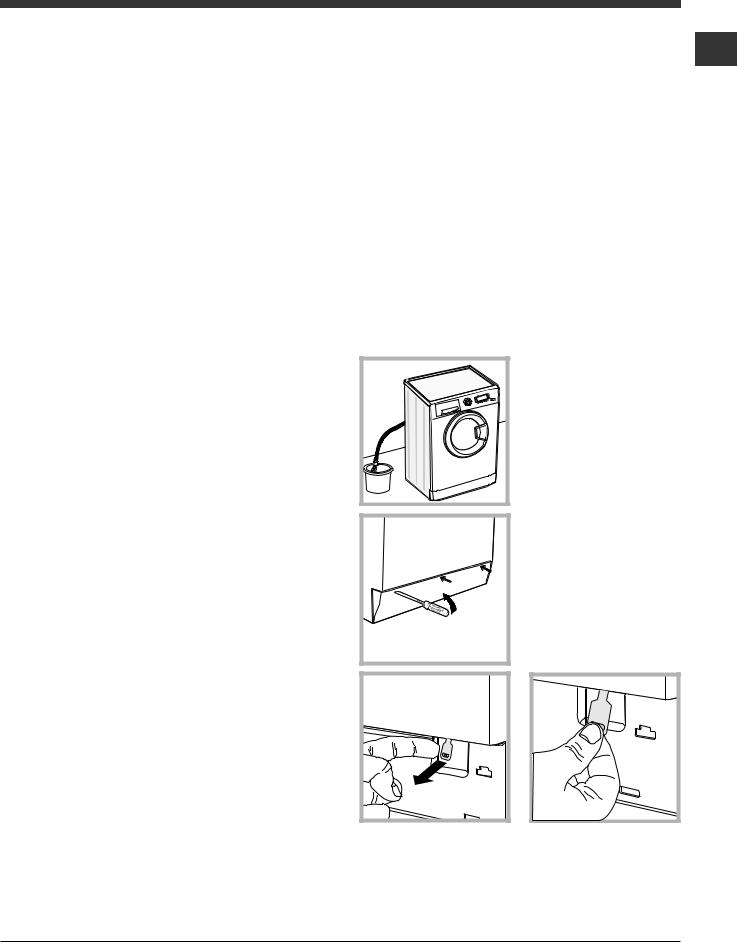
Precautions and tips
! This washer-dryer was designed and constructed in accordance with international safety regulations. The following information is provided for safety reasons and must therefore be read carefully.
General safety
•This appliance is not intended for use by persons (including children) with reduced physical, sensory or mental capabilities, or lack of experience and knowledge, unless they have been given supervision or instruction concerning use of the appliance by a person responsible for their safety.
Children should be supervised to ensure that they do not play with the appliance.
–Do not dry unwashed items in the tumble dryer.
–Items that have been soiled with substances such as cooking oil, acetone, alcohol, petrol, kerosene, spot removers, turpentine, waxes and wax removers should be washed in hot water with an extra amount of detergent before being dried in the tumble dryer.
–Items such as foam rubber (latex foam), shower caps, waterproof textiles, rubber backed articles and clothes or pillows fitted with foam rubber pads should not be dried in the tumble dryer.
–Fabric softeners, or similar products, should be used as specified by the fabric softener instructions.
–The final part of a tumble dryer cycle occurs without heat (cool down cycle) to ensure that the items are left at a temperature that ensures that the items will not be damaged.
WARNING: Never stop a tumble dryer before the end of the drying cycle unless all items are quickly removed and spread out so that the heat is dissipated.
•This appliance was designed for domestic use only.
•Do not touch the machine when barefoot or with wet or damp hands or feet.
•Do not pull on the power supply cable when unplugging the appliance from the electricity socket. Hold the plug and pull.
•Do not touch the drained water as it may reach extremely high temperatures.
•Never force the porthole door. This could damage the safety lock mechanism designed to prevent accidental opening.
•If the appliance breaks down, do not under any circumstances access the internal mechanisms in an attempt to repair it yourself.
•Always keep children well away from the appliance while it is operating.
•If it must be moved, proceed with the help of two or three people and handle it with the utmost care. Never try to do this alone, because the appliance is very heavy.
•Before loading laundry into the washer dryer, make sure the drum is empty.
•During the drying phase, the door tends to get quite hot.
•Do not use the appliance to dry clothes that have been washed with flammable solvents (e.g. trichlorethylene).
•Do not use the appliance to dry foam rubber or similar elastomers.
•Make sure that the water tap is turned on during the drying cycles.
Disposal |
GB |
|
•Disposing of the packaging materials: observe local regu- |
||
|
||
lations so that the packaging may be re-used. |
|
|
•The European Directive 2002/96/EC on Waste Electrical |
|
|
and Electronic Equipment, requires that old household |
|
|
electrical appliances must not be disposed of in the normal |
|
|
unsorted municipal waste stream. Old appliances must be |
|
|
collected separately in order to optimise the recovery and |
|
|
recycling of the materials they contain and reduce the im- |
|
|
pact on human health and the environment. The crossed |
|
|
out “wheeled bin” symbol on the product reminds you of |
|
|
your obligation, that when you dispose of the appliance it |
|
|
must be separately collected. Consumers should contact |
|
|
their local authority or retailer for information concerning the |
|
|
correct disposal of their old appliance. |
|
|
Opening the porthole door manually |
|
|
In the event that it is not possible to open the porthole |
|
|
door due to a powercut, and if you wish to remove the |
|
|
laundry, proceed as follows: |
|
|
1. remove the plug from the |
|
|
electrical socket. |
|
|
2. make sure the water level |
|
|
inside the machine is lower |
|
|
than the door opening; if it |
|
|
is not, remove excess water |
|
|
using the drain hose, collec- |
|
|
ting it in a bucket as indicated |
|
|
in the figure. |
|
|
3. using a screwdriver, |
|
|
remove the cover panel on |
|
|
the lower front part of the |
|
|
washer-dryer (see figure). |
|
4.pull outwards using the tab as indicated in the figure, until the plastic tie-rod is freed from its stop position; pull downwards and open the door at the same time.
5.reposition the panel, making sure the hooks are securely in place before you push it onto the appliance.
9
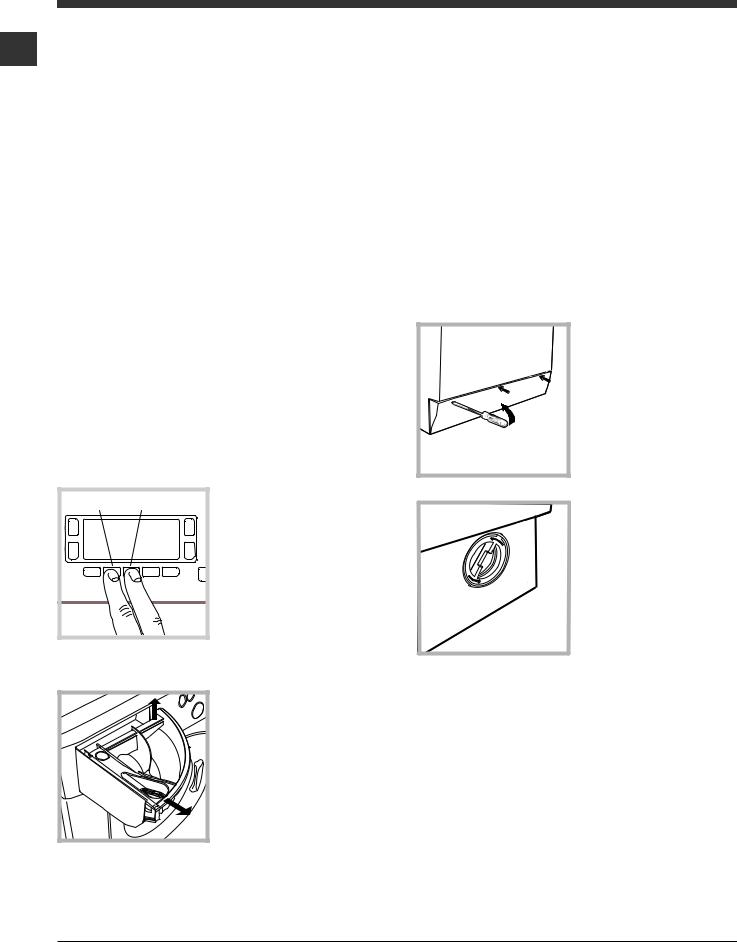
Care and maintenance
Cutting off the water and electricity GB supplies
•Turn off the water tap after every wash cycle. This will limit wear on the hydraulic system inside the washer-dryer and help to prevent leaks.
•Unplug the washer-dryer when cleaning it and during all maintenance work.
Cleaning the washer-dryer
•The outer parts and rubber components of the appliance can be cleaned using a soft cloth soaked in lukewarm soapy water. Do not use solvents or abrasives.
•The washer-dryer has a “Auto Clean” programme for its internal parts that must be run with no load in the drum. For maximum performance you may want to use either the detergent (i.e. a quantity 10% the quantity specified for lightly-soiled garments) or special additives to clean the
washer-dryer. We recommend running a cleaning programme every 40 wash cycles.
To start the programme press buttons A and B simultaneously for 5 seconds (see figure).
The programme will start automatically and will last approximately 70 minutes. To stop the cycle press the START/ PAUSE button.
A |
B |
Cleaning the detergent dispenser drawer
1 |
2 |
Remove the dispenser by raising it and pulling it out
(see figure).
Wash it under running water; this operation should be repeated frequently.
Caring for the door and drum of your appliance
•Always leave the porthole door ajar in order to prevent unpleasant odours from forming.
Cleaning the pump
The washer-dryer is fitted with a self-cleaning pump which does not require any maintenance. Sometimes, small items (such as coins or buttons) may fall into the pre-chamber which protects the pump, situated in its bottom part.
! Make sure the wash cycle has finished and unplug the appliance.
To access the pre-chamber:
1. using a screwdriver, remove the cover panel on the lower front part of the washer-dryer (see figure);
2. unscrew the lid by rotating it anti-clockwise (see figure): a little water may trickle out. This is perfectly normal;
3.clean the inside thoroughly;
4.screw the lid back on;
5.reposition the panel, making sure the hooks are securely in place before you push it onto the appliance.
Checking the water inlet hose
Check the inlet hose at least once a year. If there are any cracks, it should be replaced immediately: during the wash cycles, water pressure is very strong and a cracked hose could easily split open.
! Never use second-hand hoses.
10

Troubleshooting
|
|
|
|
Your washer-dryer could fail to work. Before contacting the Technical Assistance Centre (see “Assistance”), make sure that |
|
||
GB |
|||
the problem cannot be not solved easily using the following list. |
|||
|
|||
|
|
|
|
Problem: |
Possible causes / Solutions: |
|
The washer-dryer does not switch on. |
• |
The appliance is not plugged into the socket fully, or is not making contact. |
|
• |
There is no power in the house. |
The wash cycle does not start.
The washer-dryer does not take in water (the text “NO WATER, CHECK SUPPLY” appears on the display).
The washer-dryer continuously takes in and
drains water.
•The washer-dryer door is not closed properly.
•The ON/OFF button has not been pressed.
•The START/PAUSE button has not been pressed.
•The water tap has not been opened.
•A delayed start has been set (see “How to run a wash cycle or a drying cycle”).
•The water inlet hose is not connected to the tap.
•The hose is bent.
•The water tap has not been opened.
•There is no water supply in the house.
•The pressure is too low.
•The START/PAUSE button has not been pressed.
•The drain hose is not fitted at a height between 65 and 100 cm from the floor
(see “Installation”).
•The free end of the hose is under water (see “Installation”).
•The wall drainage system is not fitted with a breather pipe.
If the problem persists even after these checks, turn off the water tap, switch the appliance off and contact the Assistance Service. If the dwelling is on one of the upper floors of a building, there may be problems relating to water drainage, causing the washer-dryer to fill with water and drain continuously. Special antidraining valves are available in shops and help to avoid this inconvenience.
The washer-dryer does not drain or spin.
•The wash cycle does not include draining: some wash cycles require the drain phase to be started manually (see “Wash cycles and functions”).
•The drain hose is bent (see “Installation”).
•The drainage duct is clogged.
The washer-dryer vibrates a lot during the spin cycle.
The washer-dryer leaks.
•The drum was not unlocked correctly during installation (see “Installation”).
•The washer-dryer is not level (see “Installation”).
•The washer-dryer is trapped between cabinets and walls (see “Installation”).
•The water inlet hose is not screwed on properly (see “Installation”).
•The detergent dispenser drawer is blocked (for cleaning instructions, see “Care and maintenance”).
•The drain hose is not fixed properly (see “Installation”).
The machine is locked and the display flashes, indicating an error code (e.g. F-01, F-..).
There is too much foam.
•Switch off the machine and unplug it, wait for approximately 1 minute and then switch it back on again. If the problem persists, contact the Technical Assistance Service.
•The detergent is not suitable for machine washing (it should display the text
“for washing machines” or “hand and machine wash”, or the like).
•Too much detergent was used.
The washer-dryer does not dry.
•The appliance is not plugged into the socket, or not enough to make contact.
•There has been a power failure.
•The appliance door is not shut properly.
•A DELAY TIMER has been set.
•DRYING is in the OFF position.
11

Service
|
|
|
|
|
|
Before calling for Assistance: |
|
GB |
|||
|
• Check whether you can solve the problem alone (see “Troubleshooting”); |
||
|
|
• Restart the programme to check whether the problem has been solved; |
|
|
|||
|
|
• If this is not the case, contact an authorised Technical Assistance Centre using the telephone number provided on the |
|
|
|
guarantee certificate. |
|
|
|
! Always request the assistance of authorised technicians. |
Have the following information to hand:
•the type of problem;
•the appliance model (Mod.);
•the serial number (S/N).
This information can be found on the data plate applied to the rear of the washer-dryer, and can also be found on the front of the appliance by opening the door.
12

Mode d’emploi
FR
Français
WDD 9640
LAVANTE SÉCHANTE
! |
Ce symbole vous rappelle de lire ce mode d’emploi. |
FR |
|
|
|
|
|
|
Sommaire
Installation, 14-15
Déballage et mise à niveau
Raccordements eau et électricité
Premier cycle de lavage
Caractéristiques techniques
Description du lavante-séchante, 16-17
Bandeau de commandes Écran
Comment effectuer un cycle de lavage ou un séchage, 18
Programmes et fonctions, 19
Tableau des programmes
Fonctions de lavage
Produits lessiviels et linge, 20
Tiroir à produits lessiviels
Triage du linge
Programmes spéciaux
Système d’équilibrage de la charge
Précautions et conseils, 21
Sécurité générale
Mise au rebut
Ouverture manuelle de la porte hublot
Entretien et soin, 22
Coupure de l’arrivée d’eau et du courant
Nettoyage du lavante-séchante
Nettoyage du tiroir à produits lessiviels.
Entretien du hublot et du tambour
Nettoyage de la pompe
Contrôle du tuyau d’arrivée de l’eau
Anomalies et remèdes, 23
Assistance, 24
13
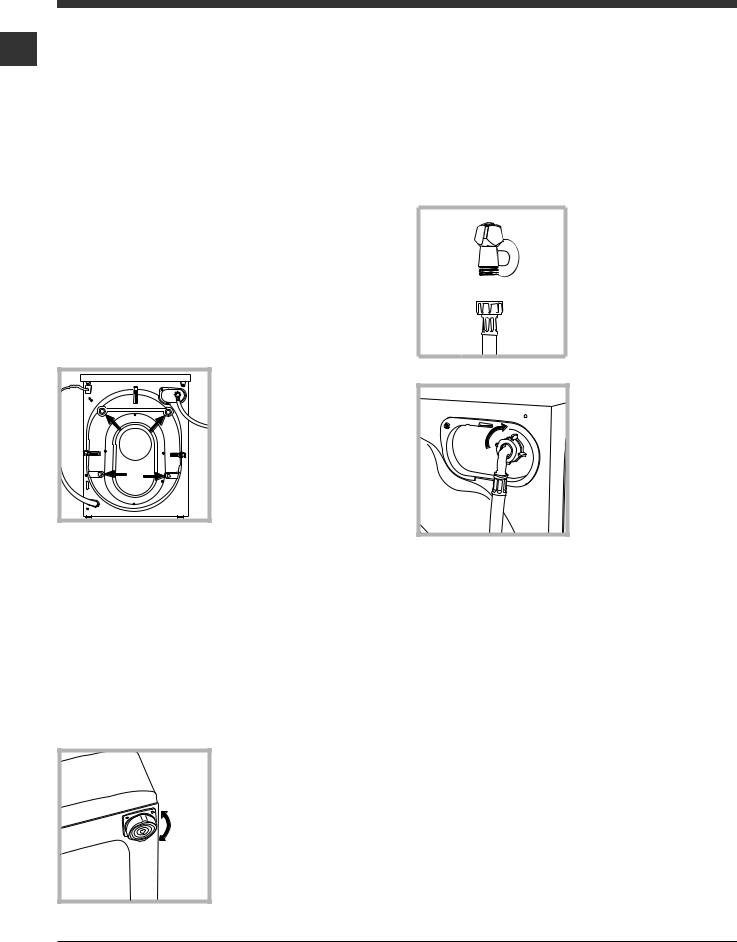
Installation
! Conserver ce mode d’emploi pour pouvoir le consulter à FR tout moment. En cas de vente, de cession ou de déménagement, veiller à ce qu’il suive toujours le lavante-séchante
pour que son nouveau propriétaire soit informé sur son mode de fonctionnement et puisse profiter des conseils correspondants.
! Lire attentivement les instructions: elles fournissent des conseils importants sur l’installation, l’utilisation et la sécurité de l’appareil.
Déballage et mise à niveau
Déballage
1. |
Déballer le lavante-séchante . |
2. |
Contrôler que le lavante-séchante n’a pas été en- |
dommagé pendant le transport. S’il est abîmé, ne pas le raccorder et contacter le vendeur.
3. Enlever les 4 vis de protection servant au transport, le caoutchouc et la cale, placés dans la partie arrière (voir figure).
4.Boucher les trous à l’aide des bouchons plastique fournis.
5.Conserver toutes ces pièces: il faudra les remonter en cas de transport du lavante-séchante .
! Les pièces d’emballage ne sont pas des jouets pour enfants.
Mise à niveau
1. Installer le lavante-séchante sur un sol plat et rigide, sans l’appuyer contre des murs, des meubles ou autre.
2. Si le sol n’est pas parfaitement horizontal, visser ou dévisser les pieds de réglage avant (voir figure) pour niveler l’appareil; son angle d’inclinaison, mesuré sur le plan de travail, ne doit pas dépasser 2°.
Une bonne mise à niveau garantit la stabilité de l’appareil et évite qu’il y ait des vibrations, du bruit et des déplacements en cours de fonctionnement. Si la machine est posée sur de la moquette ou un tapis, régler les pieds de manière à ce qu’il y ait suffisamment d’espace pour assurer une bonne ventilation.
Raccordements eau et électricité
Raccordement du tuyau d’arrivée de l’eau
1. Reliez le tuyau d’alimentation en le vissant à un robinet d’eau froide à embout fileté 3/4 gaz (voir figure).
Faire couler l’eau jusqu’à ce qu’elle soit limpide et sans impuretés avant de raccorder.
2. Raccorder le tuyau d’arrivée de l’eau au lavanteséchante en le vissant à la prise d’eau prévue, dans la partie arrière en haut à droite (voir figure).
3. Attention à ce que le tuyau ne soit pas plié ou écrasé.
!La pression de l’eau doit être comprise entre les valeurs indiquées dans le tableau des Caractéristiques techniques
(voir page ci-contre).
!Si la longueur du tuyau d’alimentation ne suffit pas, s’adresser à un magasin spécialisé ou à un technicien agréé.
!N’utiliser que des tuyaux neufs.
!Utiliser ceux qui sont fournis avec l’appareil.
14
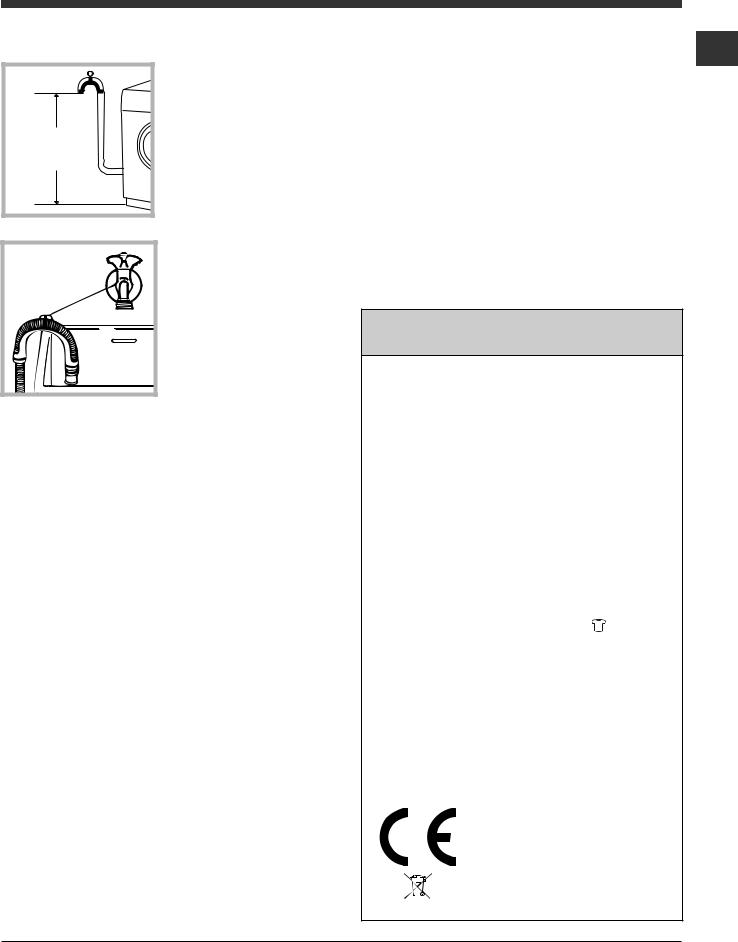
Raccordement du tuyau de vidange
65 - 100 cm |
Raccorder le tuyau d’évacuation, sans le plier, à un conduit d’évacuation ou à une évacuation murale placés à une distance du sol comprise entre 65 et 100 cm;
ou bien l’accrocher à un évier ou à une baignoire, dans ce cas, fixer le
support en plastique fourni avec l’appareil au robinet (voir figure). L’extrémité libre du tuyau d’évacuation ne doit pas être plongée dans l’eau.
! L’utilisation d’un tuyau de rallonge est absolument déconseillée mais si on ne peut faire autrement, il faut absolument qu’il ait le même diamètre que le tuyau original et sa longueur ne doit pas dépasser 150 cm.
Branchement électrique
Avant de brancher la fiche dans la prise de courant, s’assurer que:
•la prise est bien reliée à la terre et est conforme aux réglementations en vigueur;
•la prise est bien apte à supporter la puissance maximale de l’appareil indiquée dans le tableau des Caractéristiques techniques (voir ci-contre);
•la tension d’alimentation est bien comprise entre les valeurs figurant dans le tableau des Caractéristiques techniques (voir ci-contre);
•la prise est bien compatible avec la fiche du lavanteséchante . Autrement, remplacer la prise ou la fiche.
! Le lavante-séchante ne doit pas être installé dehors, même à l’abri, car il est très dangereux de le laisser exposé à la pluie et aux orages.
! Après installation du lavante-séchante , la prise de courant doit être facilement accessible.
! N’utiliser ni rallonges ni prises multiples. |
FR |
|
!Le câble ne doit être ni plié ni trop écrasé.
!Le câble d’alimentation ne doit être remplacé que par des techniciens agréés.
Attention! Nous déclinons toute responsabilité en cas de non-respect des normes énumérées ci-dessus.
Premier cycle de lavage
Avant la première mise en service de l’appareil, effectuer un cycle de lavage avec un produit lessiviel mais sans linge et sélectionner le programme  (60°C).
(60°C).
Caractéristiques techniques
Modèle |
WDD 9640 |
|||
|
|
|
|
|
|
|
|
largeur 59,5 cm |
|
Dimensions |
hauteur 85 m |
|||
|
|
|
profondeur 60,5 cm |
|
|
|
|
|
|
Capacité |
de 1 à 9 kg pour le lavage |
|||
de 1 à 6 kg pour le séchage |
||||
|
|
|
||
|
|
|
|
|
Raccordements |
Voir la plaque signalétique appliquée |
|||
électriques |
sur la machine |
|||
|
|
|
|
|
Raccordements |
pression maximale 1 MPa (10 bar) |
|||
pression minimale 0,05 MPa (0,5 |
||||
hydrauliques |
bar) capacité du tambour 62 litres |
|||
|
|
|
||
|
|
|
|
|
Vitesse d’esso- |
jusqu’à 1400 tours minute |
|||
rage |
||||
|
||||
|
|
|
|
|
|
|
|
lavage: programme ; tempéra- |
|
|
|
|
ture 60°C (2° pression de la touche); |
|
|
|
|
effectué avec une charge de 9 kg. |
|
Programmes de |
séchage: pour le séchage de la |
|||
charge de linge réduite, sélectionner |
||||
contrôle selon |
le niveau de séchage « INTENSIF », |
|||
la norme |
le linge doit comprendre: 3 draps, |
|||
EN 50229 |
2 taies d’oreiller et 1 serviette de |
|||
|
|
|
toilette; |
|
|
|
|
pour le séchage de la charge de |
|
|
|
|
linge restante, sélectionner le niveau |
|
|
|
|
de séchage « INTENSIF ». |
|
|
|
|
|
|
|
|
|
Cet appareil est conforme aux Directi- |
|
|
|
|
ves Communautaires suivantes: |
|
|
|
|
- 2004/108/CE (Compatibilité élec- |
|
|
|
|
tromagnétique) |
|
|
|
|
- 2006/95/CE (Basse Tension) |
|
|
|
|
- 2002/96/CE |
|
|
|
|
||
|
|
|
||
15

Description du lavante-séchante
FR |
Bandeau de commandes |
|
Touche |
|
Touche |
|
Touche |
|
|
|||
ON/OFF |
|
INTENSITE |
|
SÉCAHGE |
|
|
DE LAVAGE |
|
|
|
|
|
|
|
Écran
|
|
Touche |
|
Touche avec voyant |
|
Touches |
|
START/PAUSE |
|
|
MEMO |
Touches |
||
Tiroir à produits lessiviels |
SÉLECTEUR |
|
FONCTION |
|
PROGRAMMES |
|
Touche |
||
|
|
|||
|
|
|
|
TEMPÉRATURE |
|
|
Touche |
Touche |
Touche |
|
|
ANTI- |
DÉPART |
|
|
|
VERROUILLAGE |
||
|
|
ALLERGIES |
DIFFÉRÉ |
|
|
|
TOUCHES |
||
|
|
|
|
Tiroir à produits lessiviels: pour charger les produits lessiviels et les additifs (voir “Produits lessiviels et linge”).
Touche ON/OFF  : appuyer brièvement sur la touche pour allumer ou éteindre l’appareil. Le voyant vert START/ PAUSE clignotant lentement indique que la machine est allumée. Pour éteindre le lavante-séchante en cours de lavage, appuyer sur la touche pendant au moins 3 secondes de suite ; une pression brève ou accidentelle n’entraîne pas l’arrêt de l’appareil. L’arrêt de l’appareil pendant un lavage annule le lavage en cours.
: appuyer brièvement sur la touche pour allumer ou éteindre l’appareil. Le voyant vert START/ PAUSE clignotant lentement indique que la machine est allumée. Pour éteindre le lavante-séchante en cours de lavage, appuyer sur la touche pendant au moins 3 secondes de suite ; une pression brève ou accidentelle n’entraîne pas l’arrêt de l’appareil. L’arrêt de l’appareil pendant un lavage annule le lavage en cours.
Touches SÉLECTEUR PROGRAMMES: pour sélectionner le programme désiré (voir “Tableau des programmes”).
Touche MEMO: maintenir la touche enfoncée pour mémoriser un cycle et les personnalisations préférées. Pour retourner à un cycle précédemment mémorisé, appuyer sur la touche MEMO.
Touches FONCTION: appuyer sur la touche pour sélectionner la fonction désirée. Le voyant correspondant s’affiche à l’écran.
Touche INTENSITE DE LAVAGE  : appuyer pour sélectionner l’intensité de lavage désirée.
: appuyer pour sélectionner l’intensité de lavage désirée.
Touche ANTI-ALLERGIES  : appuyer pour sélectionner le type de rinçage désiré.
: appuyer pour sélectionner le type de rinçage désiré.
Touche SÉCAHGE  : appuyer pour sélectionner un cycle de séchage.
: appuyer pour sélectionner un cycle de séchage.
Touche TEMPERATURE  : appuyer pour diminuer la température : la valeur correspondante est affichée à l’écran.
: appuyer pour diminuer la température : la valeur correspondante est affichée à l’écran.
Touche VERROUILLAGE TOUCHES  : pour activer le verrouillage des commandes, garder la touche enfoncée pendant environ 2 secondes. Le symbole
: pour activer le verrouillage des commandes, garder la touche enfoncée pendant environ 2 secondes. Le symbole  allumé indique que le bandeau de commandes est verrouillé. Ceci permet d’éviter toute modification involontaire des programmes, surtout s’il y a des enfants à la maison. Pour désactiver le verrouillage des commandes, garder la touche enfoncée pendant environ 2 secondes.
allumé indique que le bandeau de commandes est verrouillé. Ceci permet d’éviter toute modification involontaire des programmes, surtout s’il y a des enfants à la maison. Pour désactiver le verrouillage des commandes, garder la touche enfoncée pendant environ 2 secondes.
Touche DÉPART DIFFÉRÉ  : appuyer sur cette touche pour sélectionner un départ différé pour le programme choisi. Le retard est affiché à l’écran.
: appuyer sur cette touche pour sélectionner un départ différé pour le programme choisi. Le retard est affiché à l’écran.
Touche avec voyant START/PAUSE : quand le voyant vert clignote lentement, appuyer sur la touche pour démarrer un lavage. Une fois le cycle lancé, le voyant passe à l’allumage fixe. Pour activer une pause de lavage, appuyer à nouveau sur la touche ; le voyant passe à l’orange et se met à clignoter. Si le symbole  n’est pas allumé, il est possible d’ouvrir le hublot. Pour faire redémarrer le lavage exactement à l’endroit de l’arrêt, appuyer une nouvelle fois sur la touche.
n’est pas allumé, il est possible d’ouvrir le hublot. Pour faire redémarrer le lavage exactement à l’endroit de l’arrêt, appuyer une nouvelle fois sur la touche.
Stand-by
Ce lavante-séchante , conformément aux nouvelles normes en vigueur dans le domaine de l’économie d’énergie, est équipée d’un système d’extinction automatique (veille) activé après 30 minutes environ d’inutilisation. Appuyez brièvement sur la touche ON/OFF et attendre que la machine soit réactivée.
16
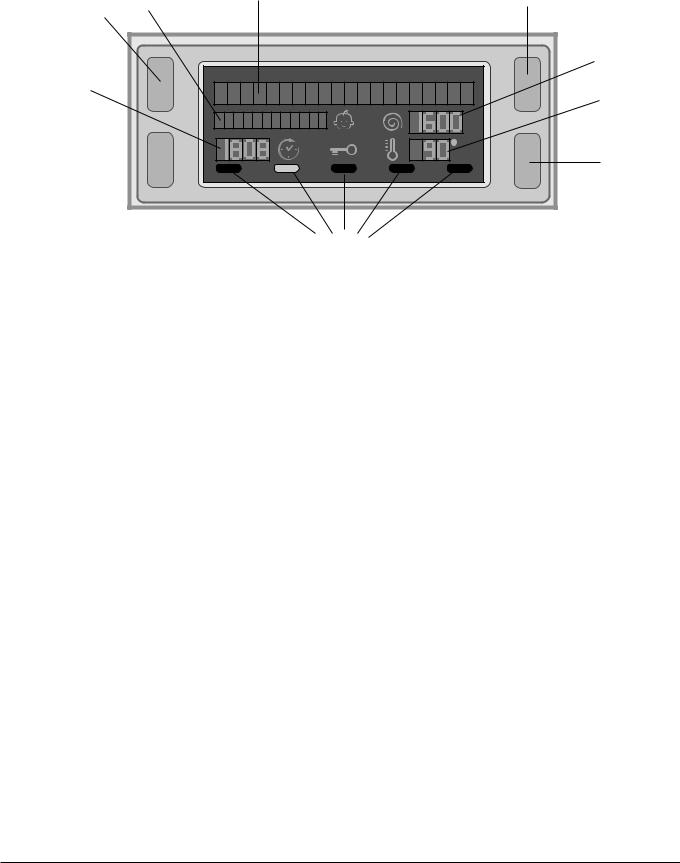
|
|
|
|
|
|
Écran |
|
|
|
|
|
|
|
|
|
FR |
|
|
|
|
|
|
|
Z |
B |
A |
X |
|
|
|
|||||
|
|
|
|
|
|
|
D |
C |
E |
|
|
|
Y |
F
L’écran est utile pour programmer la machine et fournit de multiples renseignements.
Les deux chaînes supérieures A et B affichent le programme de lavage ou le type de séchage sélectionné, la phase de lavage en cours (le niveau de séchage ou le temps de séchage sélectionné) ainsi que toutes les indications sur le stade d’avancement du programme.
La chaîne C affiche le temps restant à la fin du cycle de lavage en cours et si un DÉPART DIFFÉRÉ a été sélectionné, le temps restant avant le démarrage du programme sélectionné.
La chaîne D affiche la valeur maximum de la vitesse d’essorage que la machine peut effectuer en fonction du programme sélectionné ; si le programme ne prévoit pas d’essorage, la chaîne reste éteinte.
La chaîne E affiche la valeur maximale de la température qui peut être sélectionnée en fonction du programme choisi ; si le programme ne prévoit pas la sélection de la température, la chaîne reste éteinte.
Les voyants F correspondent aux fonctions et s’allument quand la fonction programmée est compatible avec le programme sélectionné.
Symbole verrouillage hublot 
Le symbole allumé indique que le hublot est verrouillé pour éviter toute ouverture accidentelle. Pour éviter d’abîmer l’appareil, attendre que le symbole s’éteigne avant d’ouvrir le hublot.
N.B.: si la fonction DÉPART DIFFÉRÉ est active, le hublot reste verrouillé, pour l’ouvrir mettre la machine en pause en appuyant sur la touche START/PAUSE .
! À la première mise en service, un message s’affiche demandant de sélectionner la langue et l’écran entre automatiquement dans le menu de sélection de la langue.
Pour choisir la langue désirée, appuyer sur les touches X et Y; pour confirmer la sélection, appuyer sur la touche Z.
Pour changer de langue, éteindre l’appareil, appuyer simultanément sur les touches X, Y et Z jusqu’au signal sonore, le menu de sélection de la langue s’affichera à nouveau
17

Comment effectuer un cycle de lavage ou un séchage
1. METTRE L’APPAREIL SOUS TENSION. Appuyer sur la
FR touche , l’inscription BONJOUR s’affiche à l’écran ; le voyant de START/PAUSE passe au vert et clignote lentement.
2.CHARGER LE LINGE. Ouvrir la porte hublot. Charger le linge en faisant attention à ne pas dépasser la quantité indiquée dans le tableau des programmes de la page suivante.
3.DOSER LE PRODUIT LESSIVIEL. Sortir le tiroir et placer le produit lessiviel dans les bacs correspondants comme indiqué au paragraphe “Detersifs et linge”.
4.FERMER LE HUBLOT.
5.CHOISIR LE PROGRAMME. Appuyer sur l’une
des touches du SÉLECTEUR PROGRAMMES pour sélectionner le programme désiré ; le nom du programme est affiché à l’écran avec attribution d’une température et d’une vitesse d’essorage qui peuvent être modifiées. La durée du cycle s’affiche sur l’écran.
6.PERSONNALISER LE CYCLE DE LAVAGE. Appuyer sur les touches correspondantes :
Modifier la température. L’appareil sélectionne automatiquement la température maximales prévues pour
le programme sélectionné qui ne peuvent par conséquent pas être augmentées. Par pression sur la touche 
 on peut diminuer progressivement la température de lavage jusqu’à un
on peut diminuer progressivement la température de lavage jusqu’à un
lavage à froid “OFF”. Une autre pression sur la touche ramènera le valeur aux maximales prévues.
Sélectionner un départ différé.
Pour programmer le départ différé d’un programme sélectionné, appuyer sur la touche correspondante jusqu’à ce que le retard désiré soit atteint. Quand cette option
est active, le symbole 

 s’affiche à l’écran. Pour annuler le départ différé, appuyer sur la touche jusqu’à ce que l’inscription OFF s’affiche à l’écran.
s’affiche à l’écran. Pour annuler le départ différé, appuyer sur la touche jusqu’à ce que l’inscription OFF s’affiche à l’écran.
Sélectionner le séchage
Pour sélectionner le type de séchage souhaité, appuyer une ou plusieurs fois de suite sur la touche SÉCHAGE  . Deux possibilités sont offertes :
. Deux possibilités sont offertes :
A - En fonction du degré d’humidité du linge:
A repasser: linge légèrement humide, facile à repasser. Sur cintre: idéal pour le linge n’exigeant pas de séchage complet. A ranger: conseillé pour le linge à ranger dans l’armoire sans repassage.
Intensif: conseillé pour le linge exigeant un séchage complet, serviettes éponge et peignoirs par exemple.
B - En fonction du temps : de 20 à 180 min.
Pour supprimer le séchage, appuyer sur la touche correspondante jusqu’à affichage de OFF.
Si, exceptionnellement, la charge de linge à laver et faire sécher dépasse la charge maximum prévue, procéder au lavage et une fois le programme terminé, séparer le linge dont une partie sera replacée dans le tambour. Suivre à présent les instructions pour procéder au “Séchage seulement”. Procéder de même pour le linge restant. Un cycle de refroidissement est toujours prévu quand le séchage est terminé.
Séchage seulement
Sélectionner à l’aide du bouton programmes un séchage
(


 ) en fonction du type de tissu. Possibilité de sélectionner le niveau ou le temps de séchage souhaité à l’aide de
) en fonction du type de tissu. Possibilité de sélectionner le niveau ou le temps de séchage souhaité à l’aide de
la touche SÉCHAGE  .
.
En cas de sélection à l’aide du bouton programmes du séchage coton et en appuyant sur la touche « Eco », un séchage automatique aura lieu. Ce dernier permet de faire des économies d’énergie grâce à une combinaison optimale entre température de l’air et durée du cycle. Affichage sur l’écran du niveau de séchage «Eco».
Programmer l’intensité de lavage désirée.
L’option permet d’optimiser le lavage selon le degré de salissure des
permet d’optimiser le lavage selon le degré de salissure des tissus et l’intensité de lavage désirée. Sélectionner le programme de lavage, le cycle se place
tissus et l’intensité de lavage désirée. Sélectionner le programme de lavage, le cycle se place
automatiquement sur le niveau «Normal» optimisé pour du linge moyennement sale, (cette sélection n’est pas acceptée pour
le cycle «Laine», qui se règle automatiquement sur le niveau «Délicat»). Pour du linge très sale, appuyer sur la touche jusqu’à ce que le niveau «Super Lavage» soit atteint. Ce niveau permet d’obtenir un lavage très performant car l’utilisation d’une plus grande quantité d’eau au cours de la phase initiale du cycle et un brassage mécanique plus intense permettent d’éliminer les taches les plus difficiles; possibilité d’utilisation avec ou sans eau de Javel. Pour traiter le linge avec de l’eau de Javel, ajouter le bac supplémentaire 4 fourni avec l’appareil à l’intérieur du bac 1. Au moment de verser l’eau de Javel, attention à ne pas dépasser le niveau «max» indiqué sur le pivot central (voir figure page
jusqu’à ce que le niveau «Super Lavage» soit atteint. Ce niveau permet d’obtenir un lavage très performant car l’utilisation d’une plus grande quantité d’eau au cours de la phase initiale du cycle et un brassage mécanique plus intense permettent d’éliminer les taches les plus difficiles; possibilité d’utilisation avec ou sans eau de Javel. Pour traiter le linge avec de l’eau de Javel, ajouter le bac supplémentaire 4 fourni avec l’appareil à l’intérieur du bac 1. Au moment de verser l’eau de Javel, attention à ne pas dépasser le niveau «max» indiqué sur le pivot central (voir figure page
20). Pour du linge peu sale ou pour un traitement plus délicat des tissus, appuyer sur la touche jusqu’à ce que le niveau «Délicat» soit atteint. Ce cycle réduira
jusqu’à ce que le niveau «Délicat» soit atteint. Ce cycle réduira le brassage mécanique pour assurer des résultats de lavage parfaits du linge délicat. S’il n’est pas possible de sélectionner ou de modifier le réglage existant, le message «INACTIF» s’affiche.
le brassage mécanique pour assurer des résultats de lavage parfaits du linge délicat. S’il n’est pas possible de sélectionner ou de modifier le réglage existant, le message «INACTIF» s’affiche.
Programmer le type de rinçage.
L’option permet de sélectionner le type de rinçage désiré pour un maximum de protection des peaux sensibles. Une première pression sur la touche programme le niveau «Extra Rinçage» qui permet d’ajouter un rinçage supplémentaire à ceux normalement prévus par le cycle de manière à éliminer toute trace de lessive. Une deuxième pression sur la touche programme le niveau «Peaux sensibles» qui permet d’ajouter deux rinçages supplémentaires à ceux normalement prévus par le cycle, il est conseillé pour les peaux extrêmement sensibles. Une troisième pression sur la touche programme le niveau «Anti-allergies»
qui permet d’ajouter trois rinçages supplémentaires à ceux normalement prévus par le cycle, pour éliminer les principaux allergènes tels que pollens, acariens, poils de chien ou de chat. Appuyer une nouvelle fois pour retourner au type de rinçage «Rinçage Normal». S’il n’est pas possible de sélectionner ou de modifier le réglage existant, le message «INACTIF» s’affiche.
Modifier les caractéristiques du cycle.
•Appuyer sur la touche pour activer la fonction; le voyant correspondant à la touche s’allume.
•Appuyer de nouveau sur la touche pour désactiver la fonction ; le voyant s’éteint.
!Si la fonction sélectionnée est incompatible avec le programme sélectionné, le voyant se met à clignoter et la fonction n’est pas activée.
!Si la fonction sélectionnée est incompatible avec une autre fonction précédemment sélectionnée, le voyant correspondant à la première fonction se met à clignoter et seule la deuxième fonction est activée alors que le voyant de la fonction activée s’allume.
!Les fonctions permettent de modifier le chargement conseillé et/ou la durée du cycle de lavage.
7.DEMARRER LE PROGRAMME. Appuyer sur la touche START/PAUSE . Le voyant correspondant s’allume en vert fixe et le hublot est verrouillé (symbole HUBLOT VERROUILLÉ  allumé). Pendant le lavage, le nom de la phase en cours s’affiche à l’écran. Pour modifier un programme lorsqu’un
allumé). Pendant le lavage, le nom de la phase en cours s’affiche à l’écran. Pour modifier un programme lorsqu’un
cycle est en cours, mettre le lavante-séchante en pause en appuyant sur la touche START/PAUSE (le voyant START/ PAUSE passe à l’orange et clignote lentement); sélectionner le cycle désiré et appuyer de nouveau sur la touche START/ PAUSE . Pour ouvrir la porte tandis qu’un cycle est en cours, appuyer sur la touche START/PAUSE ; si le symbole HUBLOT VERROUILLÉ  est éteint, on peut ouvrir le hublot. Pour faire redémarrer le programme exactement à l’endroit de l’arrêt, appuyer une nouvelle fois sur la touche START/PAUSE .
est éteint, on peut ouvrir le hublot. Pour faire redémarrer le programme exactement à l’endroit de l’arrêt, appuyer une nouvelle fois sur la touche START/PAUSE .
8.FIN DU PROGRAMME. Elle est signalée par l’inscription “FIN DE CYCLE” qui s’affiche à l’écran; quand le symbole HUBLOT VERROUILLÉ  s’éteint, on peut ouvrir le hublot. Ouvrir le
s’éteint, on peut ouvrir le hublot. Ouvrir le
hublot, vider le lavante-séchante et éteindre l’appareil.
! Une pression prolongée sur la touche permet d’annuler un cycle déjà lancé. Le cycle est interrompu et la machine s’éteint.
18
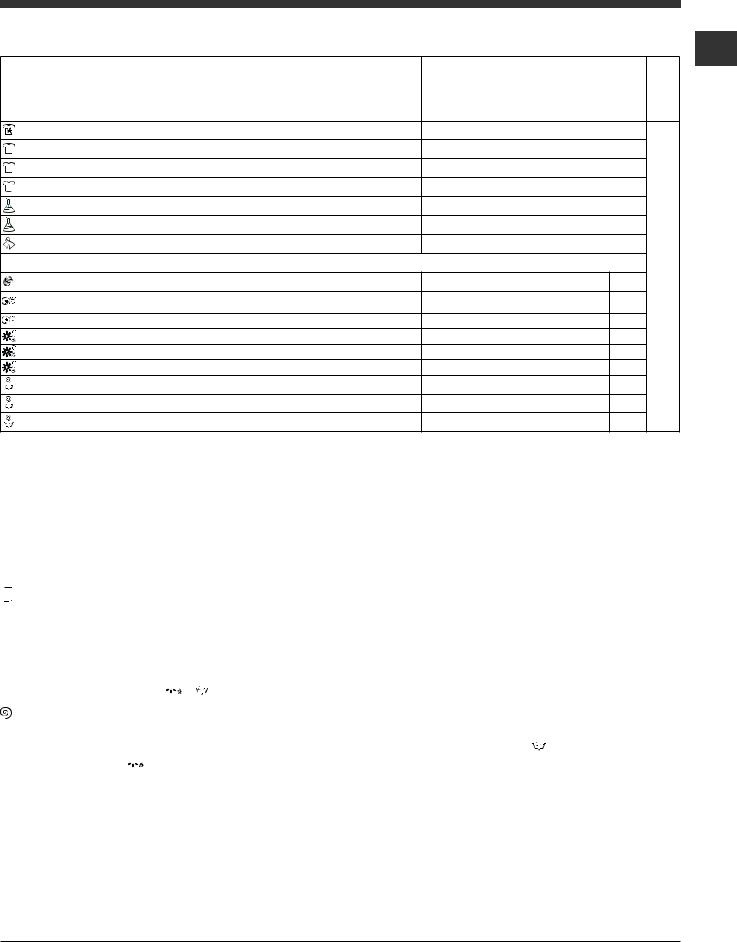
Programmes et fonctions
Tableau des programmes |
FR |
|
Programmes |
|
Temp. |
Vitesse |
|
Description du Programme |
maxi. |
maxi |
|
(tours |
||
|
|
(°C) |
minute) |
|
Anti-taches |
40° |
1400 |
|
Coton Prélavage (1° pression de la touche): blancs extrêmement sales. |
90° |
1400 |
|
Coton Blanc (1) (2° pression de la touche): blancs et couleurs résistantes très sales. |
60° |
1400 |
|
Coton Couleur (2) (3° pression de la touche): blancs et couleurs délicates peu sales. |
40° |
1400 |
|
Synthétique Intensif (1° pression de la touche): couleurs résistantes très sales. |
60° |
800 |
|
Synthétique Delicat (2° pression de la touche): couleurs résistantes peu sales. |
40° |
800 |
|
Délicat |
30° |
0 |
M |
Memo: permet de mémoriser un cycle de lavage quelconque. |
|
|
|
Woolmark Platinum (Laine): pour laine, cachemire, etc. |
|
|
|
40° |
800 |
|
|
Rapide 30' (1° pression de la touche): pour rafraîchir rapidement du linge peu |
30° |
800 |
|
sale (ne convient pas pour la laine, la soie et le linge à laver à la main). |
||
|
|
|
|
|
Lavage Séchage (2° pression de la touche) |
30° |
1400 |
|
Séchage Coton (1° pression de la touche). |
- |
- |
|
Séchage Synthétique (2° pression de la touche). |
- |
- |
|
Séchage Laine (3° pression de la touche). |
- |
- |
|
Essorage (1° pression de la touche). |
- |
1400 |
|
Rinçage (2° pression de la touche). |
- |
1400 |
|
Vidange (3° pression de la touche). |
- |
0 |
|
|
|
|
|
|
Produits lessiviels |
|||
Séchage |
|
|
|
|
|
Préla- |
|
Lavage |
Javel |
Assou- |
|
|
vage |
|
plissant |
||
|
- |
|
|
- |
|
|
|
|
|
- |
|
|
- |
|
|
|
|
|
- |
|
|
|
|
|
- |
|
|
|
|
|
- |
|
|
|
|
|
- |
|
|
- |
|
|
|
|
|
|
|
- |
|
- |
|||
|
- |
|
|
- |
|
|
- |
|
|
- |
|
|
- |
|
- |
- |
- |
|
- |
|
- |
- |
- |
|
- |
|
- |
- |
- |
|
- |
|
- |
- |
- |
|
- |
|
- |
- |
|
- |
- |
|
- |
- |
- |
|
|
|
|
|
|
Charge Durée maxi cycle (Kg)
5 |
La |
|
9 |
||
durée |
||
9 |
||
des |
||
9 |
||
programmes |
||
4 |
||
|
||
4 |
|
|
1 |
de |
|
|
||
3.5 |
estlavage |
|
2 |
contrôlable |
|
4 |
||
1 |
|
|
6 |
|
|
2 |
sur |
|
9 |
.l’afficheur |
|
|
||
9 |
|
|
9 |
|
La durée du cycle indiquée sur l’écran ou dans la notice représente une estimation calculée dans des conditions standard. Le temps effectif peut varier en fonction de nombreux facteurs tels que : température et pression de l’eau en entrée, température ambiante, quantité de lessive, quantité et type de charge, équilibrage de la charge, options supplémentaires sélectionnées.
Pour tous les instituts qui effectuent ces tests :
1)Programme de contrôle selon la norme EN 50229: sélectionner le programme  à 60°C (2° pression de la touche).
à 60°C (2° pression de la touche).
2)Programme coton long : sélectionner le programme  à 40°C (3° pression de la touche).
à 40°C (3° pression de la touche).
Fonctions de lavage


 Rapide
Rapide
La sélection de cette option permet de réduire jusqu’à 50 % la durée de lavage du cycle choisi et de faire des économies d’eau et d’énergie. Utiliser ce programme pour les vêtements modérément sales.
! Cette fonction n’est pas activable avec les programmes
 ,
,  ,
,  , “Lavage Sechage”,
, “Lavage Sechage”, 

 ,
,  .
.
1600
800
Pour réduire la vitesse d’essorage.
! Cette option n’est pas activable avec les programmes
 , “Lavage Sechage”,
, “Lavage Sechage”, 


 et “Vidange”.
et “Vidange”.
 Eco
Eco
La fonction Eco permet d’économiser l’énergie puisque l’eau utilisée pour la lessive n’est pas réchauffée : un plus pour l’environnement et pour votre facture d’électricité. L’action renforcée et l’optimisation de la consommation de l’eau garantissent d’excellents résultats pour une durée moyenne identique à celle d’un cycle standard. Pour de meilleurs résultats en matière de lavage, utilisez une lessive liquide.
! Cette fonction n’est pas activable avec les programmes
 ,
,  (90°C),
(90°C),  ,
,  , “Lavage Sechage”, “Sechage Synthétique”, “Sechage Laine”,
, “Lavage Sechage”, “Sechage Synthétique”, “Sechage Laine”,  .
.
En cas de sélection de la fonction séchage aussi, un séchage aura lieu automatiquement à la fin du lavage. Ce dernier permet lui aussi de faire des économies d’énergie grâce à une combinaison optimale entre température de l’air et durée du cycle. Affichage sur l’écran du niveau de séchage «Eco».
! Activable sur les programmes “Coton Blanc” et “Coton Couleur”.
19

Produits lessiviels et linge
FR |
Tiroir à produits lessiviels |
||||
Un bon résultat de lavage dépend aussi d’un bon dosage de |
|||||
|
|||||
|
produit lessiviel: un excès de lessive ne lave pas mieux, il incru- |
||||
|
ste l’intérieur du lavante-séchante et pollue l’environnement. |
||||
|
! Ne pas utiliser de lessives pour lavage à la main, elles |
||||
|
moussent trop. |
|
|
||
|
B |
|
A |
Sortir le tiroir à produits |
|
|
|
4 |
|
lessiviels et verser la lessive |
|
|
MAX |
|
ou l’additif comme suit. |
||
|
|
1 |
|
bac 1: Lessive prélava- |
|
|
3 |
2 |
|
ge (en poudre) |
|
|
|
|
|
Avant d’introduire la les- |
|
|
|
|
|
sive, s’assurer que le bac |
|
|
|
|
|
supplémentaire 4 n’est pas |
|
|
|
|
|
présent. |
|
bac 2: Lessive lavage (en poudre ou liquide)
En cas d’utilisation de lessive liquide, nous conseillons d’introduire le séparateur A fourni avec le lavante-séchante pour mieux déterminer la dose correcte.
En cas d’utilisation de lessive en poudre, placer le séparateur dans le bac B.
bac 3: Additifs (assouplissant, etc.)
L’assouplissant ne doit pas déborder de la grille. bac supplémentaire 4: Produit javelisé
Triage du linge
•Trier correctement le linge d’après:
-le type de textile / le symbole sur l’étiquette.
-les couleurs: séparer le linge coloré du blanc.
•Vider les poches et contrôler les boutons.
•Ne pas dépasser les valeurs indiquées correspondant au poids de linge sec :
Textiles résistants: 10 kg max. Textiles synthétiques: 5 kg max. Textiles délicats: 2 kg max. Laine: 2,5 kg max.
Soie: 2,5 kg max.
Combien pèse le linge ?
1 drap 400-500 g
1 taie d’oreiller 150-200 g
1 nappe 400-500 g
1 peignoir 900-1200 g
1 serviette éponge 150-250 g
Programmes spéciaux
Anti-taches: ce programme  est idéal pour le lavage de linge très sale, aux couleurs résistantes. Il assure une classe de lavage supérieure à la classe standard (classe A). Ce programme ne permet pas de mélanger du linge de couleurs différentes. Nous conseillons d’utiliser de la lessive en poudre. En cas de taches tenaces, nous conseillons un prétraitement avec des additifs spéciaux.
est idéal pour le lavage de linge très sale, aux couleurs résistantes. Il assure une classe de lavage supérieure à la classe standard (classe A). Ce programme ne permet pas de mélanger du linge de couleurs différentes. Nous conseillons d’utiliser de la lessive en poudre. En cas de taches tenaces, nous conseillons un prétraitement avec des additifs spéciaux.
Délicat: utiliser le programme |
pour le lavage d’articles |
particulièrement délicats avec applications de strass ou de paillettes.
Pour le lavage d’articles en soie et de rideaux, sélectionner le cycle  et programmer le niveau «Délicat» de l’option
et programmer le niveau «Délicat» de l’option  .
.
Il est recommandé de mettre le linge à l’envers avant le lavage et d’introduire les articles plus petits dans le sachet prévu pour le lavage des articles délicats.
Pour obtenir de meilleurs résultats, nous conseillons
d’utiliser de la lessive liquide spéciale textiles délicats.
En cas de sélection de la fonction de séchage temporisé, un séchage particulièrement délicat aura lieu à la fin du lavage sous forme d’un brassage léger et avec un jet d’air à une température dûment contrôlée.
Les temps conseillés sont :
1 kg de synthétique --> 150 min
1 kg de synthétique et coton --> 180 min 1 kg de coton --> 180 min
Le degré de séchage dépendra de la charge et de la composition du textile.
Laine: le cycle de lavage « Laine »  de ce lave-linge Hotpoint-Ariston a été testé et approuvé par la société Woolmark Company pour le lavage d’articles en laine classés comme lavables à la main, à condition que le lavage soit effectué conformément aux instructions indiquées sur l’étiquette du vêtement et aux indications fournies par le fabricant de l’électroménager. Hotpoint-Ariston est la première marque de lave-linge à avoir obtenu la certification Woolmark Apparel Care - Platinum délivrée par la société Woolmark Company pour ses performances de lavage et pour sa consommation d’eau et d’énergie (M1127). Lavage Séchage: utiliser le programme
de ce lave-linge Hotpoint-Ariston a été testé et approuvé par la société Woolmark Company pour le lavage d’articles en laine classés comme lavables à la main, à condition que le lavage soit effectué conformément aux instructions indiquées sur l’étiquette du vêtement et aux indications fournies par le fabricant de l’électroménager. Hotpoint-Ariston est la première marque de lave-linge à avoir obtenu la certification Woolmark Apparel Care - Platinum délivrée par la société Woolmark Company pour ses performances de lavage et pour sa consommation d’eau et d’énergie (M1127). Lavage Séchage: utiliser le programme 
 (2° pression de la touche) pour laver et sécher votre linge (Coton et Synthétiques) peu sale en un rien de temps. La sélection de ce cycle permet de laver et de sécher jusqu’à 1 kg de linge en à peine 45 minutes.
(2° pression de la touche) pour laver et sécher votre linge (Coton et Synthétiques) peu sale en un rien de temps. La sélection de ce cycle permet de laver et de sécher jusqu’à 1 kg de linge en à peine 45 minutes.
Pour obtenir de meilleurs résultats, utiliser une lessive liquide ; pré-traiter les cols, les poignets et les taches.
Système d’équilibrage de la charge
Avant tout essorage, pour éviter toute vibration excessive et répartir le linge de façon uniforme, le lavante-séchante fait tourner le tambour à une vitesse légèrement supérieure
àla vitesse de lavage. Si au bout de plusieurs tentatives, la charge n’est toujours pas correctement équilibrée, l’appareil procède à un essorage à une vitesse inférieure
àla vitesse normalement prévue. En cas de déséquilibre
excessif, le lavante-séchante préfère procéder à la répartition du linge plutôt qu’à son essorage. Pour une meilleure répartition de la charge et un bon équilibrage, nous conseillons de mélanger de grandes et petites pièces de linge.
20
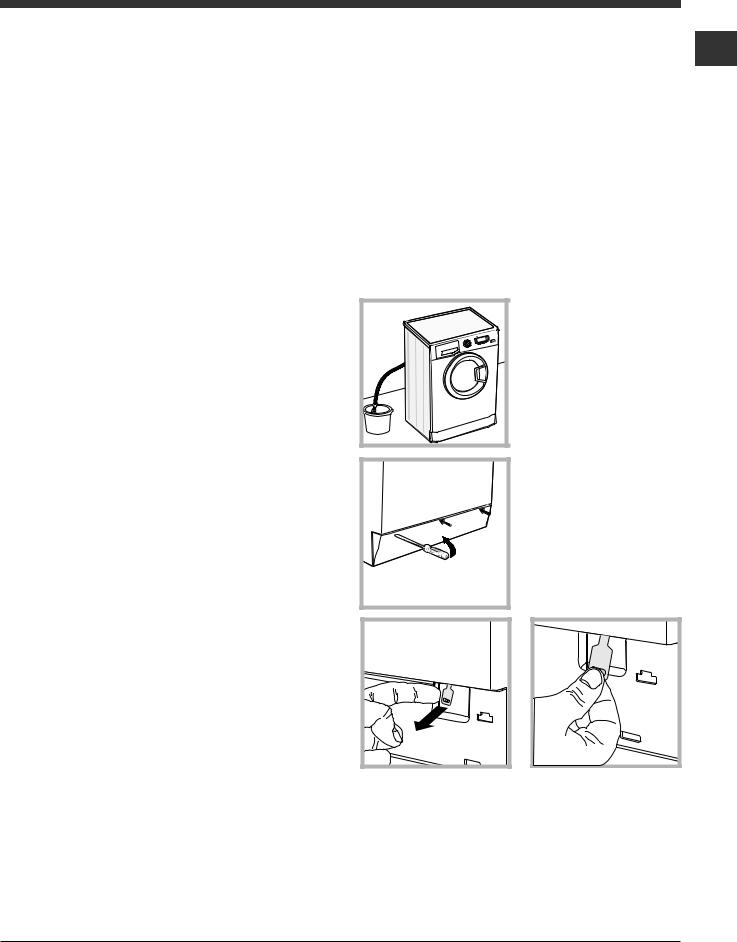
Précautions et conseils
! Ce lavante-séchante a été conçu et fabriqué conformément aux normes internationales de sécurité. Ces consignes sont fournies pour des raisons de sécurité, il faut les lire attentivement.
Sécurité générale
•Cet appareil n’est pas destiné à être utilisé par des personnes (enfants compris) dont les capacités physiques, sensorielles ou mentales sont réduites ou qui ne disposent pas des connaissances ou de l’expérience nécessaires, à moins qu’elles n’aient été formées et encadrées pour l’utilisation de cet appareil par une personne responsable de leur sécurité. Surveiller les enfants pour s’assurer qu’ils ne jouent pas avec l’appareil.
-Ne pas mettre sécher du linge non lavé.
-Le linge contaminé avec des substances telles que de l’huile de cuisson, de l’acétone, de l’alcool, de l’essence, du kérosène, des détachants, de l’essence de térébenthine, de la cire et des substances pour l’enlever, doit être lavé à l’eau chaude avec une dose supplémentaire de lessive avant d’être introduit dans le sèche-linge.
-Des objets en mousse expansée (mousse de latex), des bonnets de douche, des textiles imperméables, des articles doublés de caoutchouc et des vêtements ou des coussins ayant des parties en mousse de latex ne doivent pas être séchés en sèche-linge.
-En cas d’utilisation d’assouplissants ou de tout autre produit similaire, se conformer aux instructions du fabricant.
-La partie finale d’un cycle du sèche-linge se produit sans chaleur (cycle de refroidissement) pour éviter tout endommagement du linge.
ATTENTION: Ne jamais arrêter le sèche-linge avant la fin du programme de séchage. Dans ce cas, sortir immédiatement tout le linge et l’étendre pour le faire refroidir rapidement.
•Cet appareil est conçu pour un usage domestique.
•Ne jamais toucher l’appareil si l’on est pieds nus et si les mains sont mouillées ou humides.
•Ne jamais tirer sur le câble pour débrancher la fiche de la prise de courant.
•Ne pas toucher à l’eau de vidange, elle peut atteindre des températures très élevées.
•Ne pas forcer pour ouvrir la porte hublot : le verrouillage de sécurité qui protège contre les ouvertures accidentelles pourrait s’endommager.
•En cas de panne, éviter à tout prix d’accéder aux mécanismes internes pour tenter une réparation.
•Veiller à ce que les enfants ne s’approchent pas de l’appareil pendant son fonctionnement.
•Deux ou trois personnes sont nécessaires pour le déplacer en faisant très attention. Ne jamais le déplacer tout seul car il est très lourd.
•Avant d’introduire le linge, s’assurer que le tambour est bien vide.
Mise au rebut
•Mise au rebut du matériel d’emballage: se conformer aux réglementations locales de manière à ce que les emballages puissent être recyclés.
•La Directive Européenne 2002/96/EC sur les Déchets
des Equipements Electriques et Electroniques, exige que
les appareils ménagers usagés ne soient pas jetés dans FR le flux normal des déchets municipaux. Les appareils
usagés doivent être collectés séparément afin d’optimiser le taux de récupération et le recyclage des matériaux qui les composent et réduire l’impact sur la santé humaine et l’environnement. Le symbole de la ‘’poubelle barrée’’ est apposée sur tous les produits pour rappeler les obligations de collecte séparée. Les consommateurs devront contacter les autorités locales ou leur revendeur concernant la démarche à suivre pour l’enlèvement de leur vieil appareil.
Ouverture manuelle du hublot
A défaut de pouvoir ouvrir la porte hublot à cause d’une panne de courant pour étendre le linge, procéder comme suit :
1. débrancher la fiche de la prise de courant.
2. s’assurer que le niveau de l’eau à l’intérieur de l’appareil se trouve bien au-dessous de l’ouverture du hublot, si ce n’est pas le cas vider l’eau en excès à travers le tuyau de vidange dans un seau comme illustré voir figure.
3. démonter le panneau situé
àl’avant du lavante-séchante
àl’aide d’un tournevis (voir
figure).
4.se servir de la languette indiquée, tirer vers soi jusqu’à ce que le tirant en plastique se dégage de son cran d’arrêt; tirer ensuite vers le bas et ouvrir l’hublot en même temps.
5.remonter le panneau en veillant à bien enfiler les crochets dans les fentes prévues avant de le pousser contre l’appareil.
21
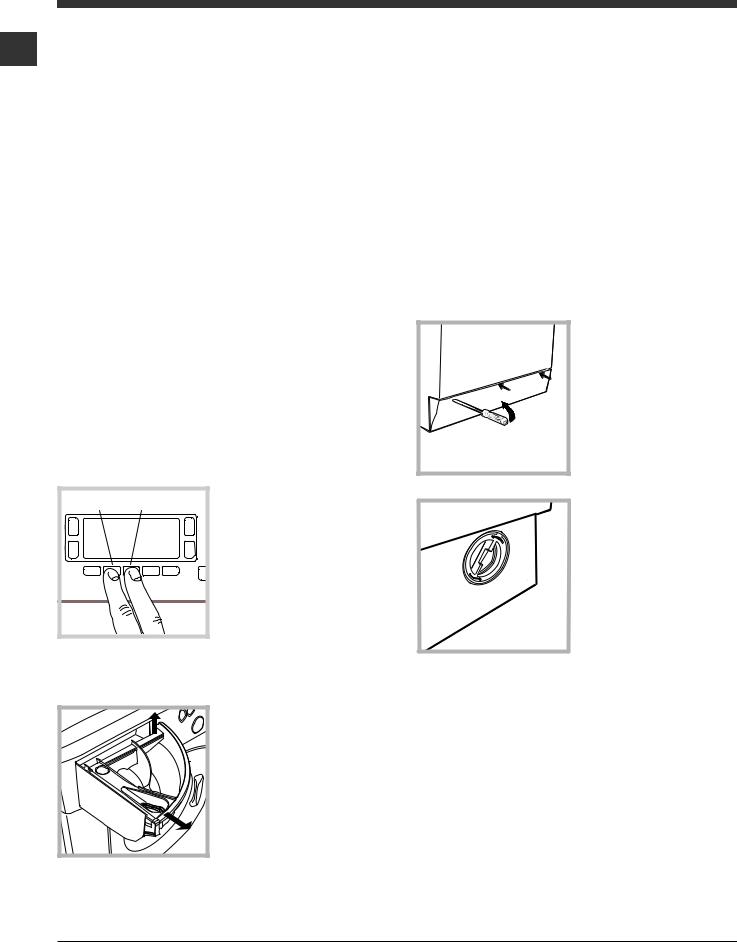
Entretien et soin
FR |
Coupure de l’arrivée d’eau et du courant |
|
•Fermer le robinet de l’eau après chaque lavage. Cela réduit l’usure de l’installation hydraulique du lavante-
séchante et évite tout danger de fuites.
• Débrancher la fiche de la prise de courant lors de tout nettoyage du lavante-séchante et pendant tous les travaux d’entretien.
Nettoyage du lavante-séchante
•Pour nettoyer l’extérieur et les parties en caoutchouc, utiliser un chiffon imbibé d’eau tiède et de savon. N’utiliser ni solvants ni abrasifs.
•Ce lavante-séchante est équipé d’un programme
«AUTO NETTOYANT» des parties internes qui doit être effectué tambour complètement vide.
La lessive (dans une quantité égale à 10% de celle conseillée pour du linge peu sale) ou les additifs spéciaux pour le nettoyage du lavante-séchante , pourront être utilisés comme adjuvants dans le programme de lavage. Il est conseillé d’effectuer le programme de nettoyage tous les 40 cycles de lavage.
Pour activer le programme, appuyer simultanément sur les touches A et B pendant 5 secondes (voir figure).
Le programme démarrera automatiquement et durera environ 70 minutes. Pour stopper le cycle, appuyer sur la touche START/PAUSE .
A |
B |
Nettoyage du tiroir à produits lessiviels.
1 |
2 |
Soulever le tiroir et le tirer vers soi pour le sortir de son logement (voir figure).
Le laver à l’eau courante; effectuer cette opération assez souvent.
Entretien du hublot et du tambour
•Il faut toujours laisser le hublot entrouvert pour éviter la formation de mauvaise odeurs.
Nettoyage de la pompe
Le lavante-séchante est équipé d’une pompe autonettoyante qui n’exige aucune opération d’entretien. Il peut toutefois arriver que de menus objets (pièces de monnaie, boutons) tombent dans la préchambre qui protège la pompe, placée en bas de cette dernière.
! S’assurer que le cycle de lavage est bien terminé et débrancher la fiche.
Pour accéder à cette préchambre: |
|
1. démonter le panneau |
|
situé à l’avant du lavante- |
|
séchante |
à l’aide d’un |
tournevis (voir figure); |
|
2. dévisser le couvercle en le tournant dans le sens inverse des aiguilles d’une montre (voir figure): il est normal qu’un peu d’eau s’écoule;
3.nettoyer soigneusement l’intérieur;
4.revisser le couvercle;
5.remonter le panneau en veillant à bien enfiler les crochets dans les fentes prévues avant de le pousser contre l’appareil.
Contrôle du tuyau d’arrivée de l’eau
Contrôler le tuyau d’alimentation au moins une fois par an. Procéder à son remplacement en cas de craquèlements et de fissures: car les fortes pressions subies pendant le lavage pourraient provoquer des cassures.
! N’utiliser que des tuyaux neufs.
22
